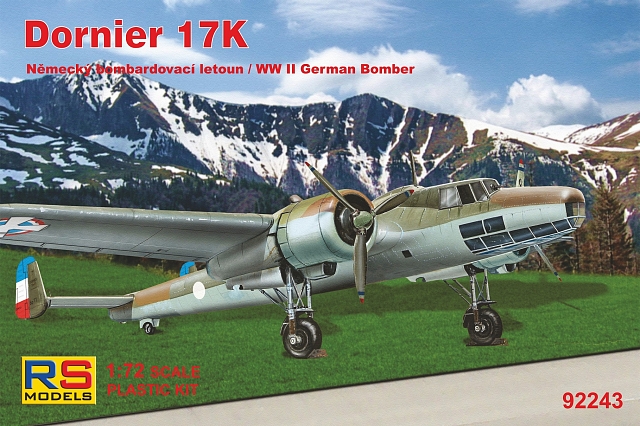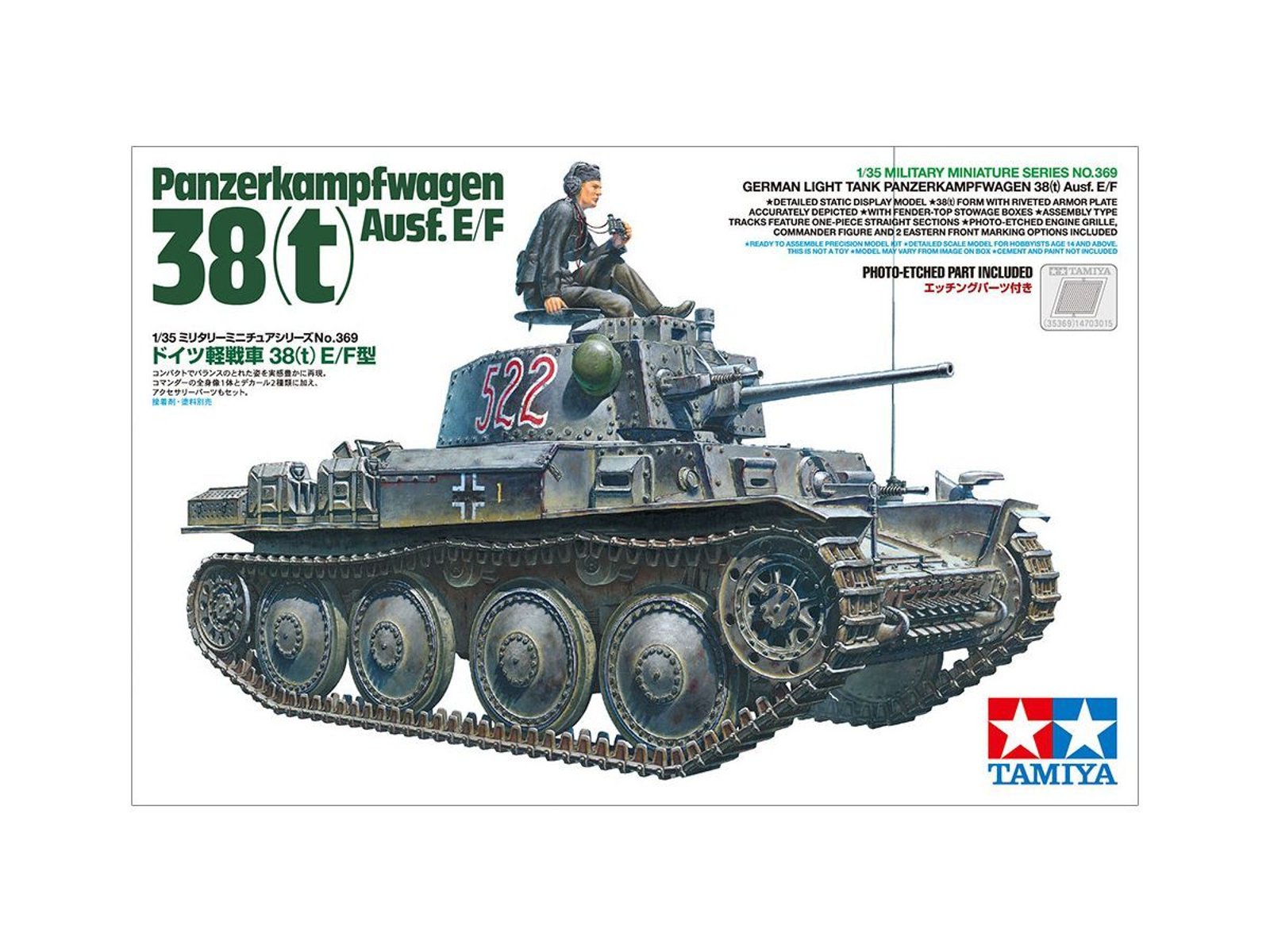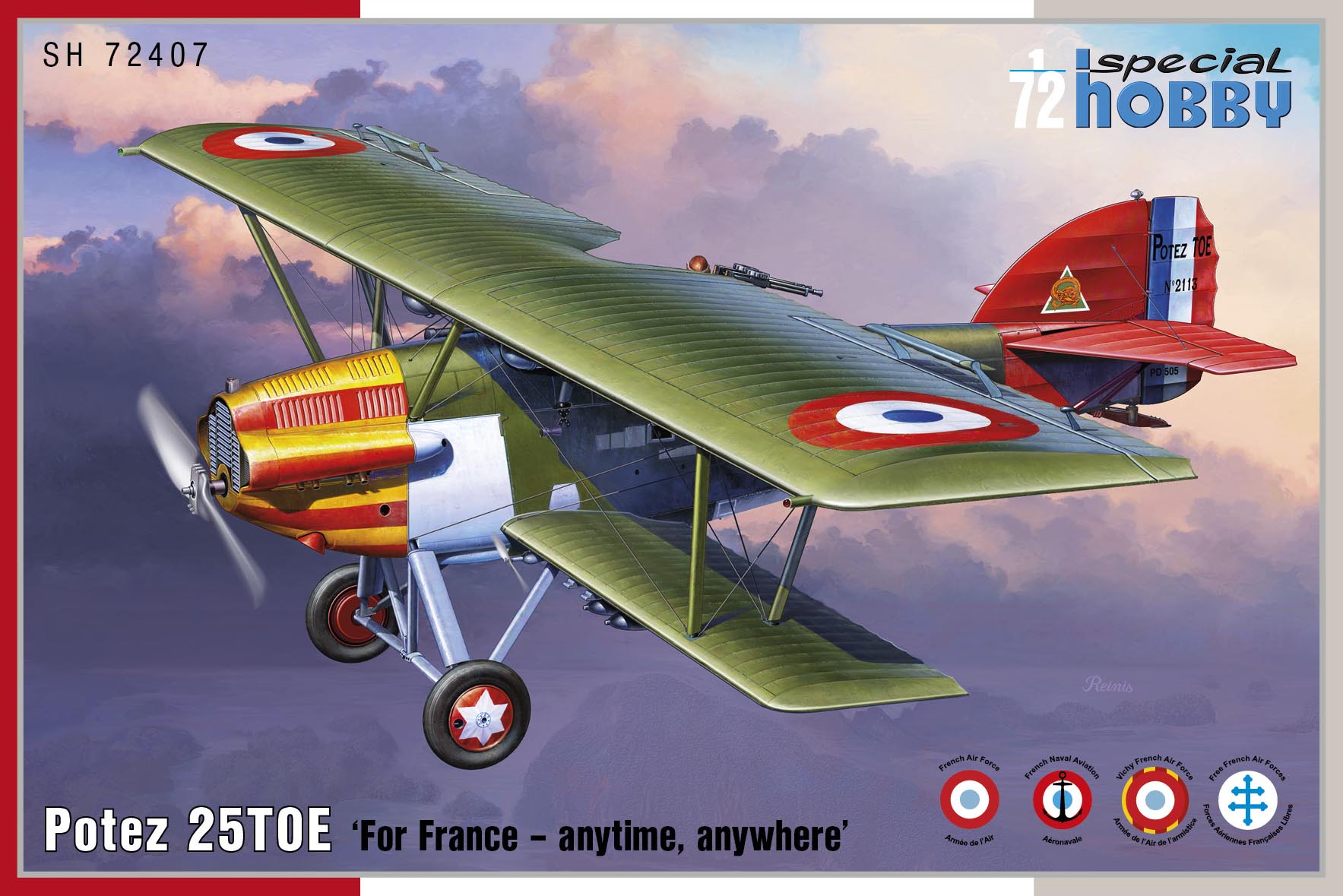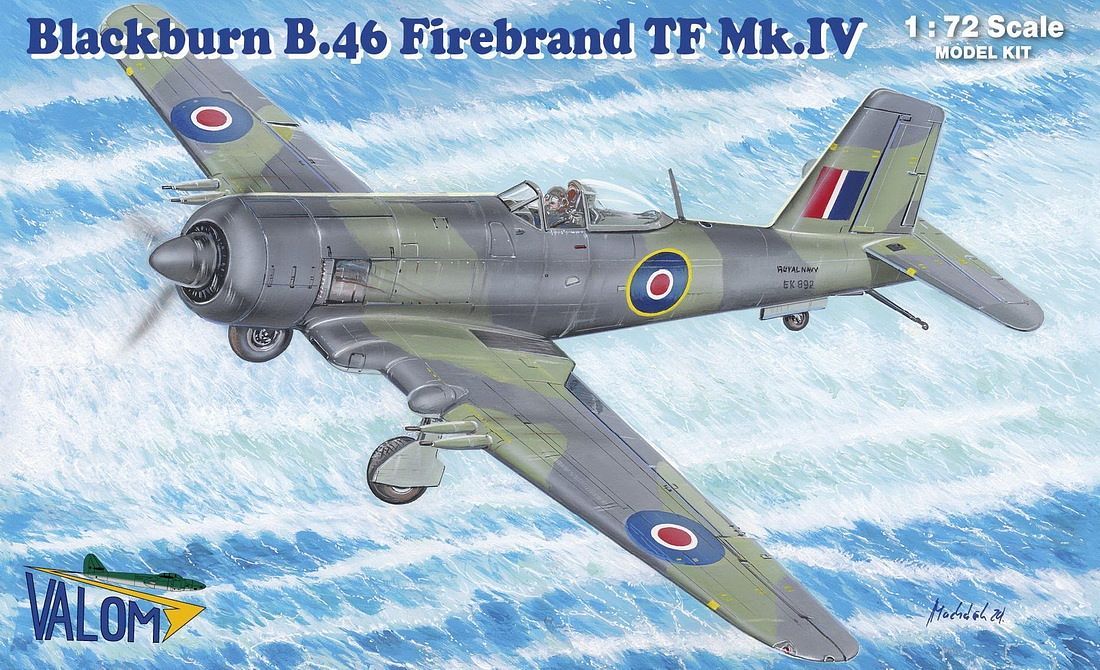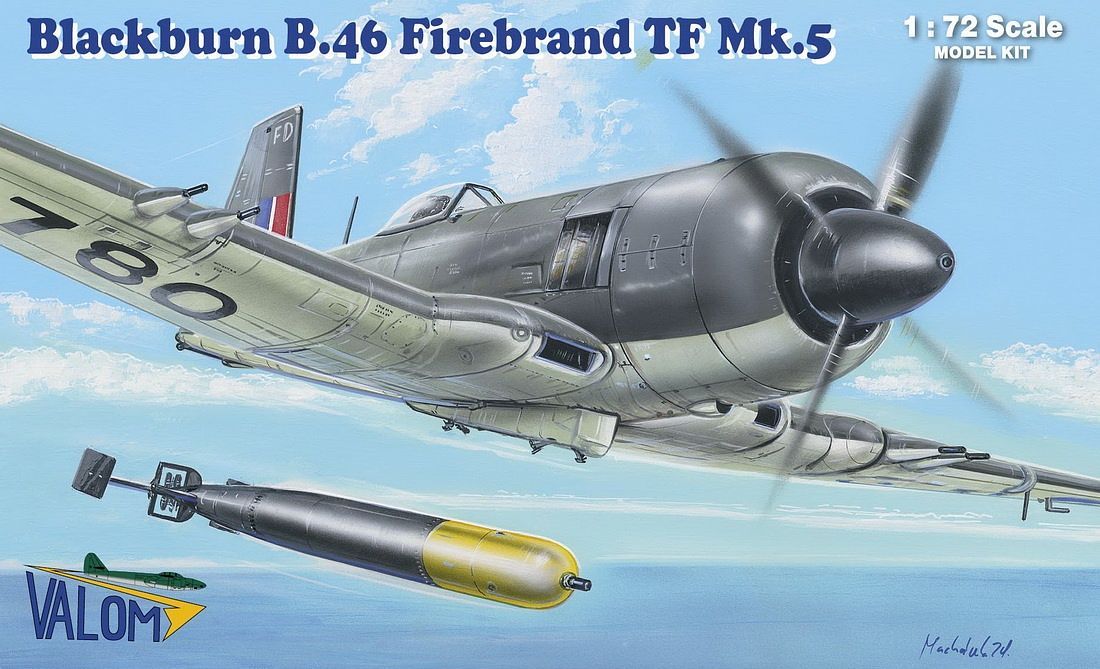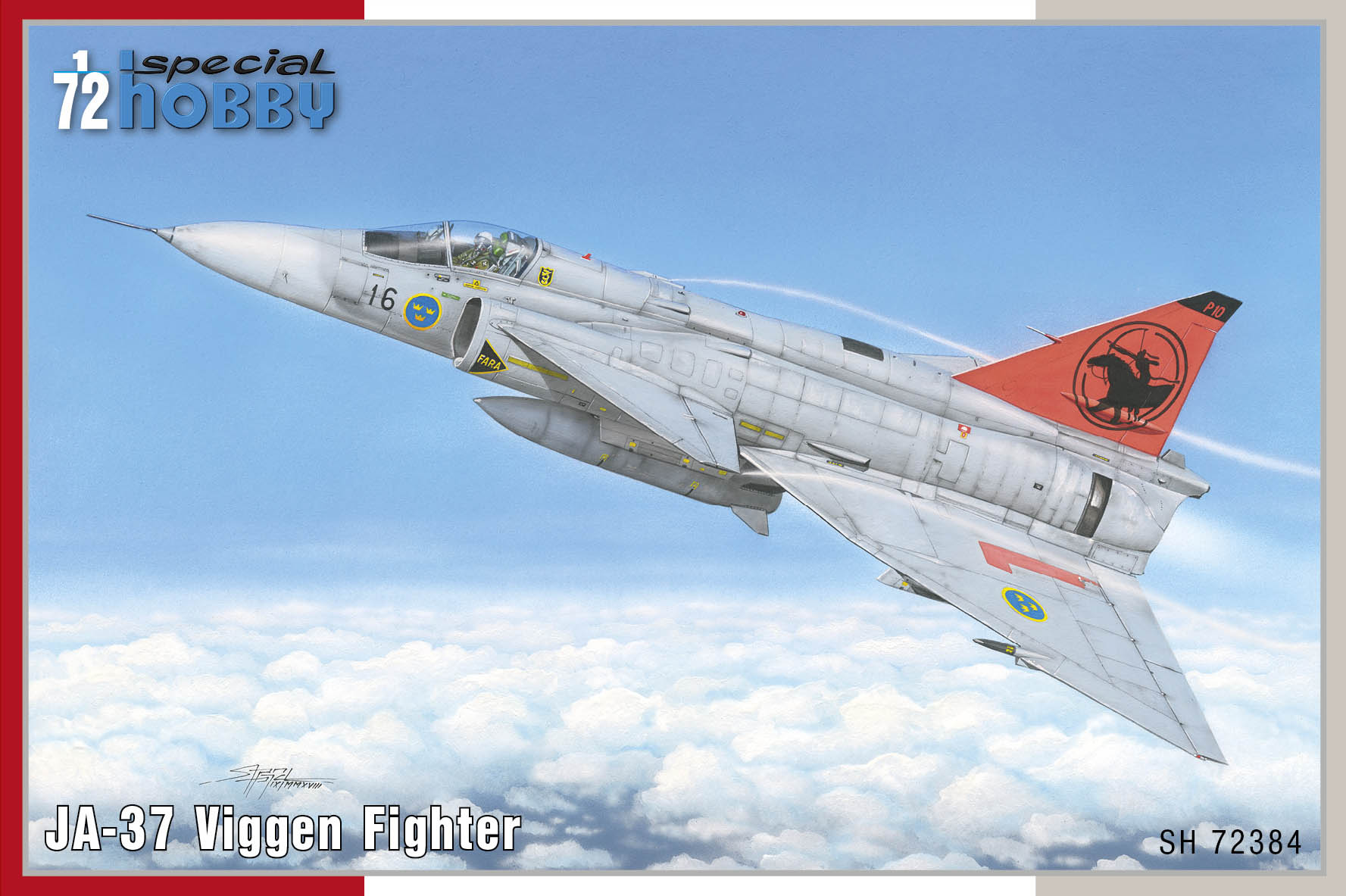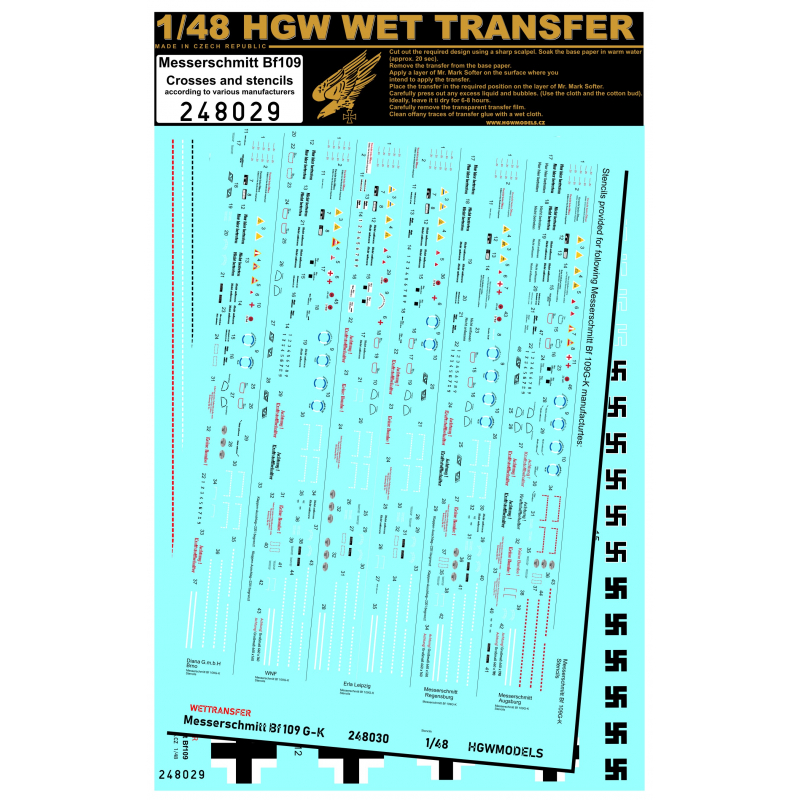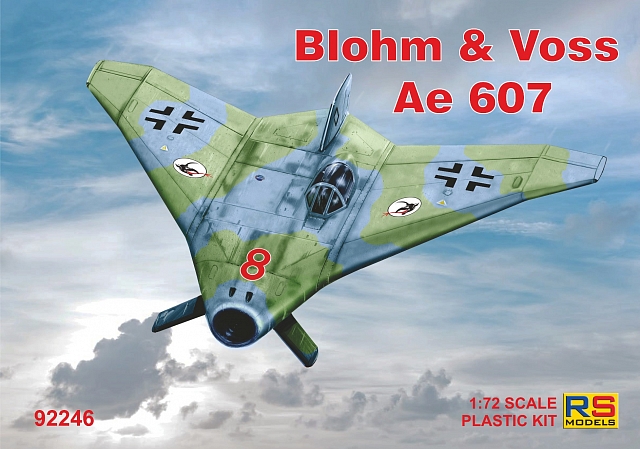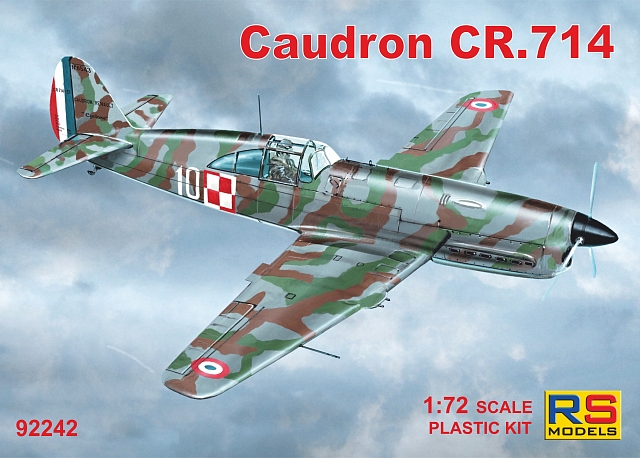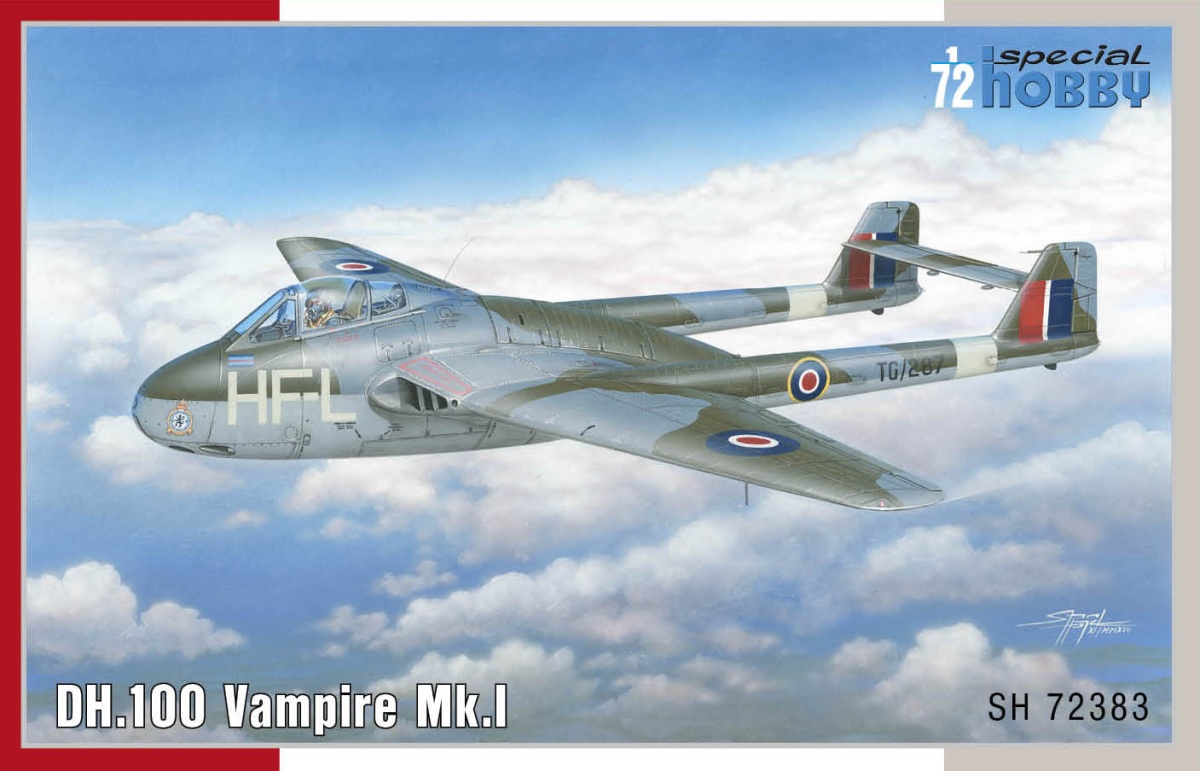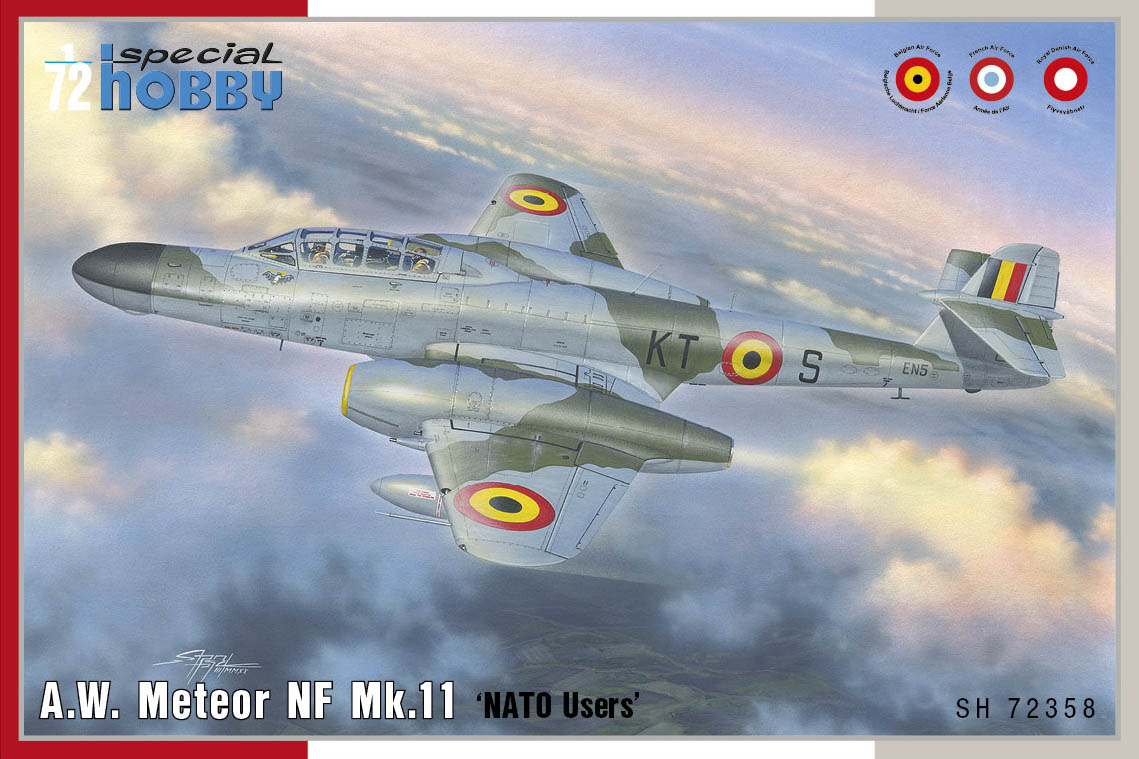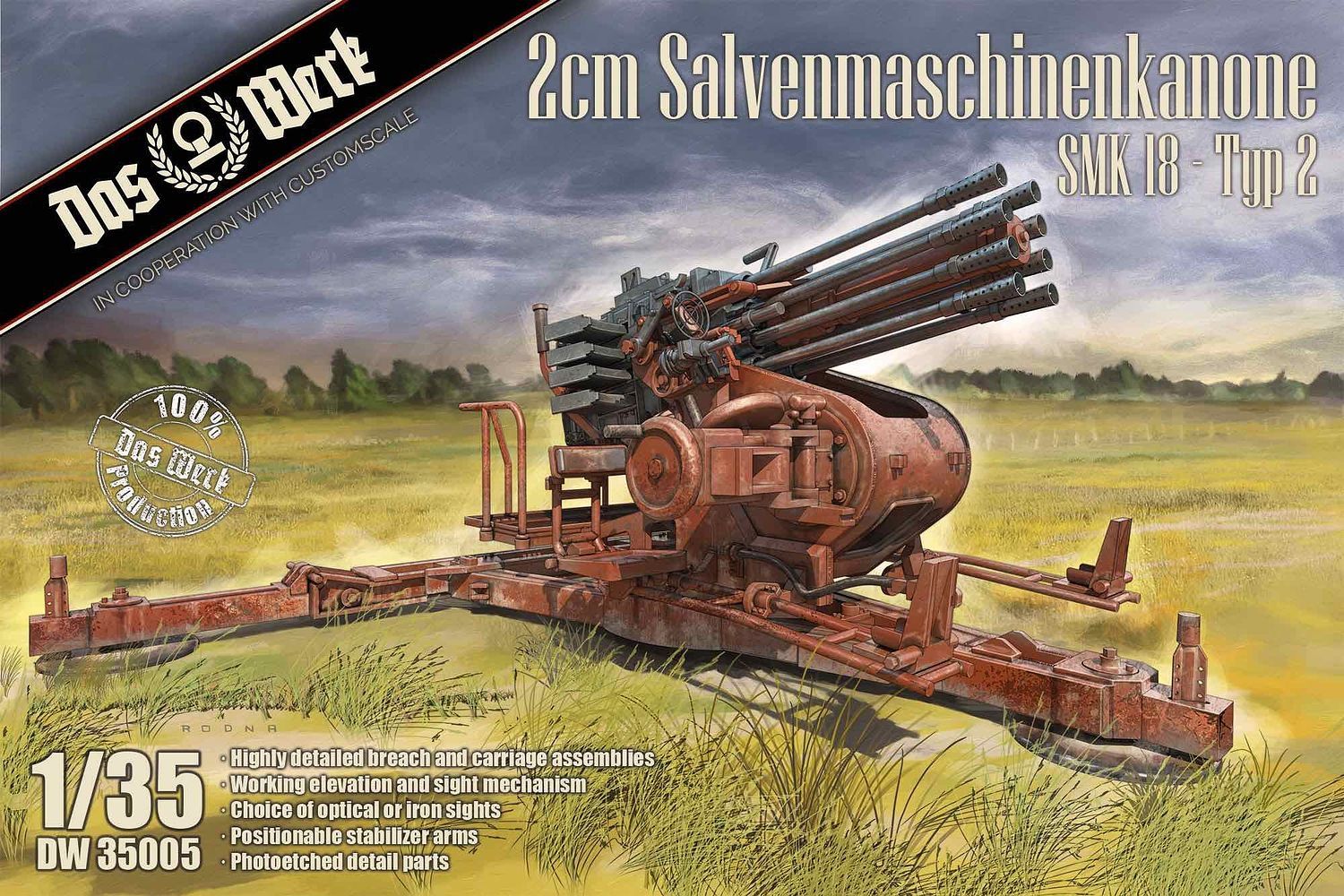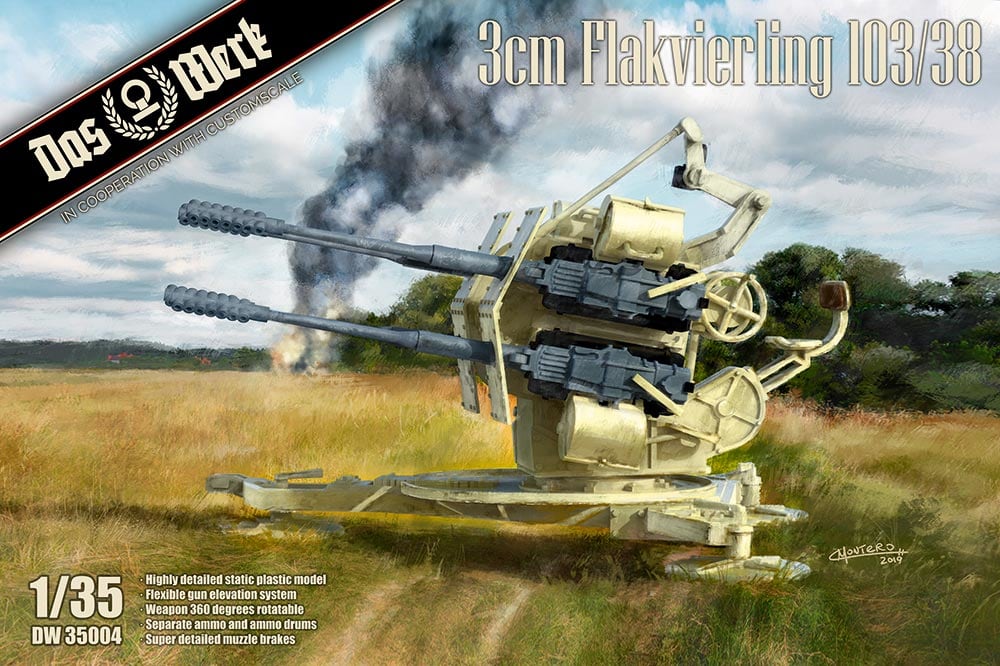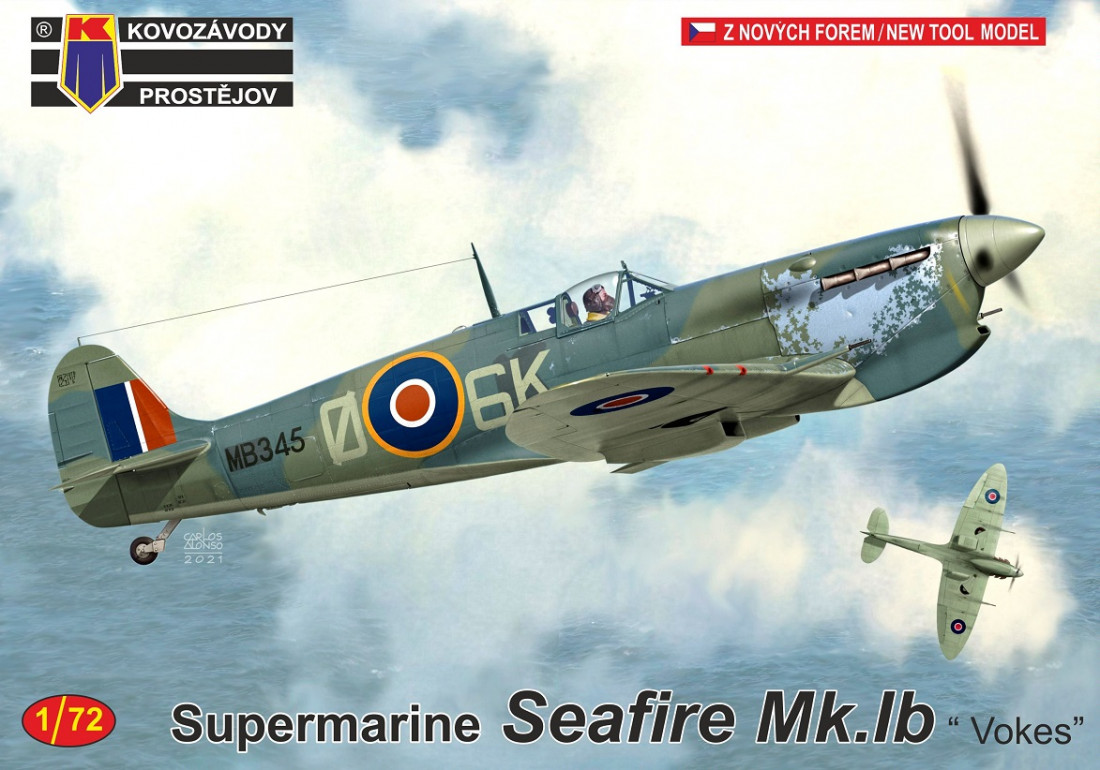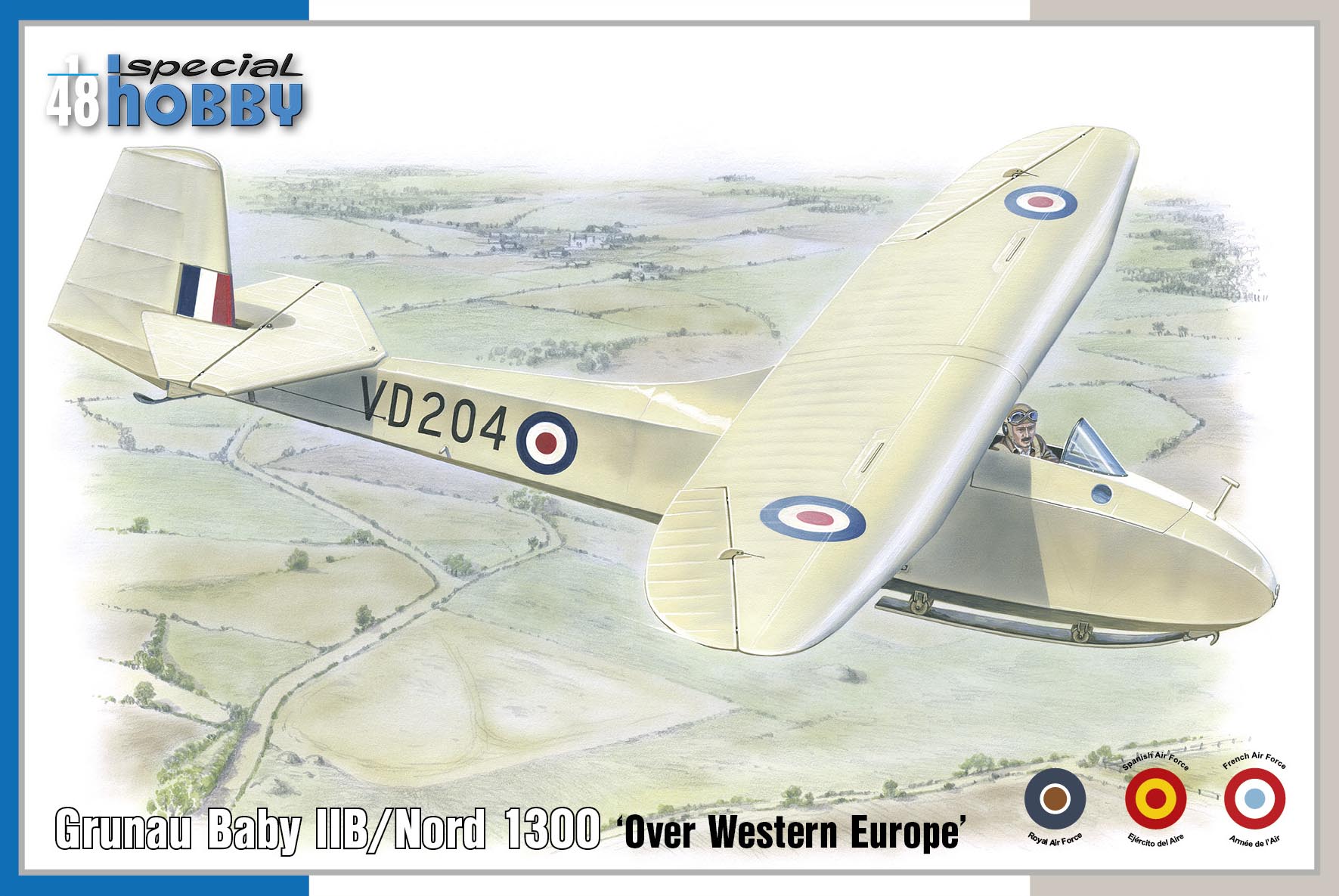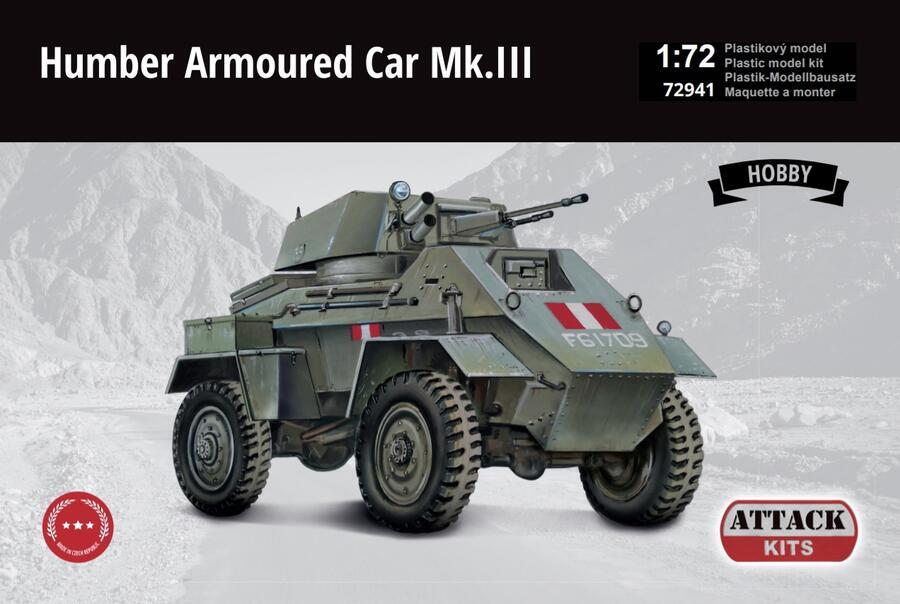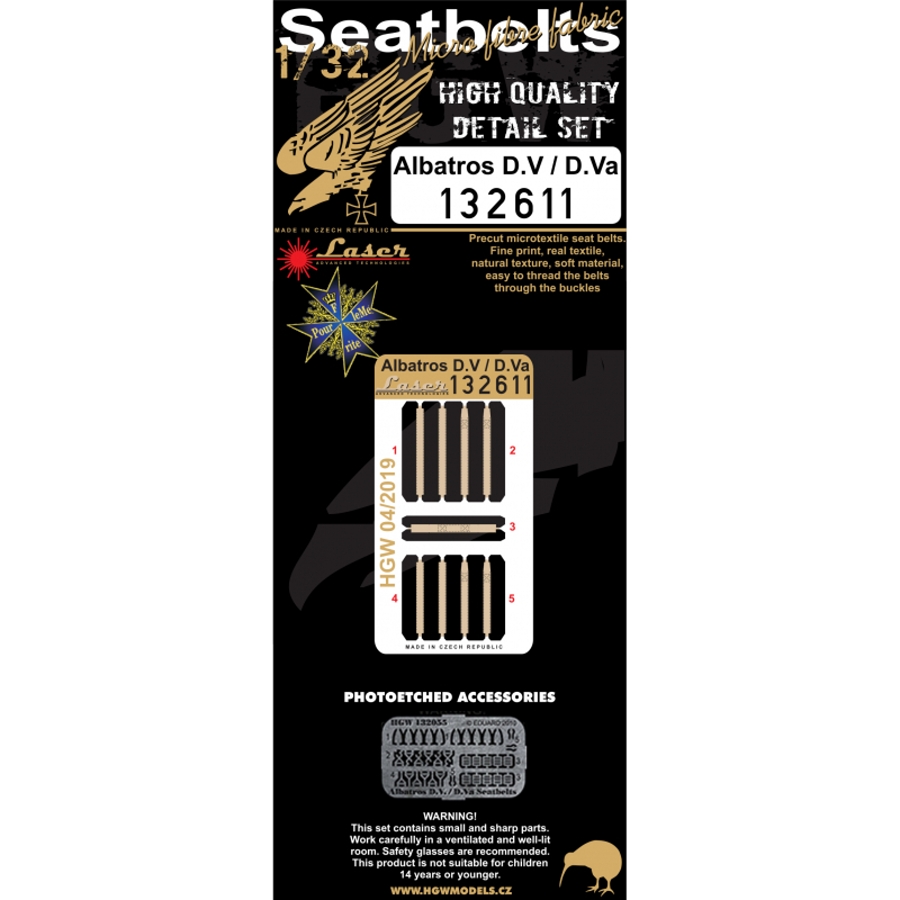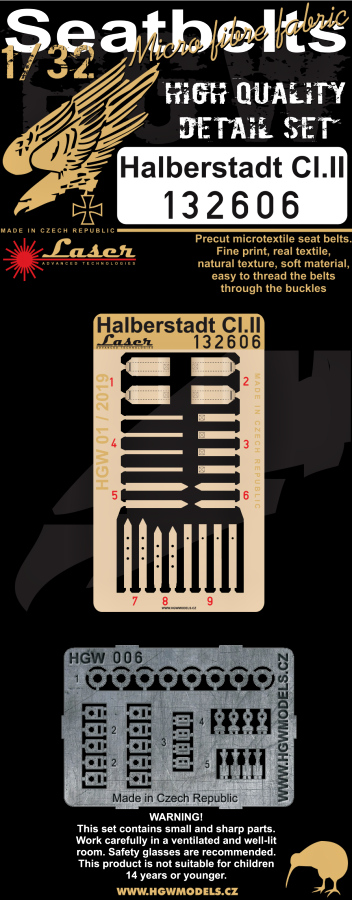Modely
Celkem 143 produktů
Plastikový model letadla 1/72 Dornier 17 K 4 decal v. for Yugoslavia, Hungary, Bulgaria. 4 decal variants1. Do-17 Ka-1, 209 eskadrila, Skoplje, June 19402. Do-17 Ka-2, 1. Önálló távolfeldelritö ostzály, Ferihegy3. Do-17 Ka-1, Mostarska eskadrila, Rajlovac, May 19454. Do-17 Ka, 5th Bomber Regiment, Bulgarian AF, 1941-42After seeing the Do 17 M V1 at the Zürich air races in 1937, the Yugoslavian Air Force bought licence rights for production at the DFA factory in 1938. They equipped it with the more powerful Gnome-Rhône 14N radial engines and added a Hispano 20 mm cannon and three 7.92 mm Browning machine guns. Three variants were built in Yugoslavia. The first being the Do 17Kb-1 bomber aircraft and the second was the Do 17Ka-2 reconnaissance aircraft. The final variant was the Do 17Ka-3 reconnaissance aircraft.
1/35 Einheitsanhänger 5t. The Anhänger 5T or 5 tonne trailer, known by the official nomenclature of „Einheitsanhanger 5 t Baumuster E 5“ was the standard medium military trailer of the German military throughout the second world war. With a load capacity of 5 tonnes, and an empty weight of approximately 2.5 tonnes, the Anhänger 5t could be seen hauling material anywhere the German military was active. Also utilized by the Luftwaffe and Kriegsmarine for transportation duties, the Anhanger 5t proved so rugged and useful that it continued to serve other masters well after the end of hostilities Highly detailed static plastic model Fine detailed multi disc wheels with sag Side and rear panels buildable in 2 different options (raised or lowered) Specific decalsheet included Drawbar and front axle fully movable
1/35 Einheitsanhänger 5t. The Anhänger 5T or 5 tonne trailer, known by the official nomenclature of „Einheitsanhanger 5 t Baumuster E 5“ was the standard medium military trailer of the German military throughout the second world war. With a load capacity of 5 tonnes, and an empty weight of approximately 2.5 tonnes, the Anhänger 5t could be seen hauling material anywhere the German military was active. Also utilized by the Luftwaffe and Kriegsmarine for transportation duties, the Anhanger 5t proved so rugged and useful that it continued to serve other masters well after the end of hostilities Highly detailed static plastic model Fine detailed multi disc wheels with sag Side and rear panels buildable in 2 different options (raised or lowered) Specific decalsheet included Drawbar and front axle fully movable
1/35 Panzerkampfwagen 38(t) Ausf.E/F. This is an injection-plastic military vehicle model kit. From Tamiya: After the effective annexation of Czechoslovakia by Nazi Germany in 1939, German forces were interested enough in the native Czech LTvz38 light tank that they took it on and ordered production under their own categorization of 38(t), a light tank with riveted, welded armor and a perky 3.7cm gun. Early production 38(t)s took part in the early German offensives of the war, and the 38(t) underwent continued development with 1,400 produced in total. Ausf.E and F 38(t)s had additional armor across the vehicle for better survivability and were deployed during the early stages of Operation Barbarossa as Nazi Germany once again invaded a neighbor, this time the Soviet Union. About the Model Length: 132mm, width: 62mm The 38(t) form with riveted armor plate is accurately depicted. Parts are included to recreate fender-top stowage boxes that were often added by units on the front line. Assembly type tracks feature single-piece straight sections for fine reproduction of upper run 'sag.' Engine grille mesh is rendered faithfully using a photo-etched component. Comes with a commander figure for installation in the hatch, and two Eastern Front marking options.
1/35 Panzerkampfwagen 38(t) Ausf.E/F. This is an injection-plastic military vehicle model kit. From Tamiya: After the effective annexation of Czechoslovakia by Nazi Germany in 1939, German forces were interested enough in the native Czech LTvz38 light tank that they took it on and ordered production under their own categorization of 38(t), a light tank with riveted, welded armor and a perky 3.7cm gun. Early production 38(t)s took part in the early German offensives of the war, and the 38(t) underwent continued development with 1,400 produced in total. Ausf.E and F 38(t)s had additional armor across the vehicle for better survivability and were deployed during the early stages of Operation Barbarossa as Nazi Germany once again invaded a neighbor, this time the Soviet Union. About the Model Length: 132mm, width: 62mm The 38(t) form with riveted armor plate is accurately depicted. Parts are included to recreate fender-top stowage boxes that were often added by units on the front line. Assembly type tracks feature single-piece straight sections for fine reproduction of upper run 'sag.' Engine grille mesh is rendered faithfully using a photo-etched component. Comes with a commander figure for installation in the hatch, and two Eastern Front marking options.
Plastikový model letadla 1/72 Potez 25 TOE - 'For France - any time, any where'. The Potez 25 biplanes enjoyed long and faithful service with the French military, it lasted from the 1920s until the end of WW2. The TOE version of the biplane was primarily destined to fly in the France’s overseas colonies. The kit offers four interesting and colourful scheme options, a Vichy machine boasting distinctive red-yellow stripes which saw service in French Indochina in 1942, a pre-war airframe with white stripes on its top wing, an Aeronavale machine which was operated over mainland France in 1940 and finally a Free French Potez as used in Syria in 1944. highly accurate and nicely detailed model four machines illustrating the type’s long service for France meticulously designed decal sheet photo-etched parts are included too Operators: France/pre WWII-WWII
Plastikový model letadla 1/72 Potez 25 TOE - 'For France - any time, any where'. The Potez 25 biplanes enjoyed long and faithful service with the French military, it lasted from the 1920s until the end of WW2. The TOE version of the biplane was primarily destined to fly in the France’s overseas colonies. The kit offers four interesting and colourful scheme options, a Vichy machine boasting distinctive red-yellow stripes which saw service in French Indochina in 1942, a pre-war airframe with white stripes on its top wing, an Aeronavale machine which was operated over mainland France in 1940 and finally a Free French Potez as used in Syria in 1944. highly accurate and nicely detailed model four machines illustrating the type’s long service for France meticulously designed decal sheet photo-etched parts are included too Operators: France/pre WWII-WWII
1/72 Blackburn Firebrand TF.Mk.IV. This is an injection-plastic aircraft model kit. The Firebrand is a single-seat aircraft developed by Blackburn Aircraft during World War II, used by the Royal Navy Air Corps. Originally developed as a fighter, it was redesigned as a strike fighter, which took six years, and the first aircraft were not delivered until after the end of the war. The Firebrand TF Mk.IV featured a 2,520bhp Centaurus IX or Centaurus 57 engine. This kit is a completely new mold, and includes resin parts for the cockpit, wheels, etc., as well as photo-etched parts and two types of Royal Navy decals. Will be approximately 16.5cm long with a wingspan of 21.7cm when completed. [Includes]: Resin parts, photo-etched parts, decals for 2 versions
1/72 Blackburn Firebrand TF.Mk.IV. This is an injection-plastic aircraft model kit. The Firebrand is a single-seat aircraft developed by Blackburn Aircraft during World War II, used by the Royal Navy Air Corps. Originally developed as a fighter, it was redesigned as a strike fighter, which took six years, and the first aircraft were not delivered until after the end of the war. The Firebrand TF Mk.IV featured a 2,520bhp Centaurus IX or Centaurus 57 engine. This kit is a completely new mold, and includes resin parts for the cockpit, wheels, etc., as well as photo-etched parts and two types of Royal Navy decals. Will be approximately 16.5cm long with a wingspan of 21.7cm when completed. [Includes]: Resin parts, photo-etched parts, decals for 2 versions
1/72 Blackburn Firebrand TF.Mk.5. This is an injection-plastic aircraft model kit. The Firebrand is a single-seat aircraft developed by Blackburn Aircraft during World War II, used by the Royal Navy Air Corps. Originally developed as a fighter, it was redesigned as a strike fighter, which took six years, and the first aircraft were not delivered until after the end of the war. This kit is a completely new mold, and includes resin parts for the cockpit, wheels, etc., as well as photo-etched parts and two types of Royal Navy decals. Will be approximately 16.5cm long with a wingspan of 21.7cm when completed. [Includes]: Resin parts, photo-etched parts, decals for 2 versions
1/72 Blackburn Firebrand TF.Mk.5. This is an injection-plastic aircraft model kit. The Firebrand is a single-seat aircraft developed by Blackburn Aircraft during World War II, used by the Royal Navy Air Corps. Originally developed as a fighter, it was redesigned as a strike fighter, which took six years, and the first aircraft were not delivered until after the end of the war. This kit is a completely new mold, and includes resin parts for the cockpit, wheels, etc., as well as photo-etched parts and two types of Royal Navy decals. Will be approximately 16.5cm long with a wingspan of 21.7cm when completed. [Includes]: Resin parts, photo-etched parts, decals for 2 versions
ModelSet loď 65808 - QUEEN MARY 2 (1:1200). Model lodi ke slepení. Velikost: 1:1200; 28,7 cm. Balení obsahuje: 45 dílků ke slepení, lepidlo, štětec, barvičky 301, 302, 88 (5 ml). Informace o originálu: Queen Mary 2 je vynikající osobní parník. Se 150,000 GRT je to největší, nejdelší (345 m), nejvyšší (o 72 m vyšší než Socha svobody) a nejvelkolepější loď, který kdy byla pro Cunard Line postavena. 2, 620 pasažérů může být ubytováno ve čtrnácti stylových a luxusně vybavených palubách spolu s posádkou 1, 253 lidí. Se svým dlouhým, elegantním trupem a výkonnými motory (max. 29 uzlů) byla speciálně navržená na zámořské cesty; z Evropy (Southampton, Anglie) do Severní Ameriky (New York) za šest dní. Koncept Queen Mary 2 byl vytvořen v květnu 1998. Po dalších dvou letech vývoje, v listopadu 2000, byla obědnána franzouzskou loděnicí a byla předána Cunard Line 22. prosince 2003. Po přezimování v Karibiku loď v dubnu 2004 vstoupila do pravidelné transatlantické služby. Queen Mary 2 pokračovala v tradici severoatlantských cest, a tak pokračovala éra oceánského cestování , která již byla považována za skončenou. Informace o modelu: - Detailní trup s mnoha strukturami - 4 motorové podvěsy s hnacími šrouby - Strukturální detaily na hlavní palubě - Detailní bazény s volitelným obtiskem - Detailní palubní nástavby - Detailní komín - Anténní kopule - 8 člunů, 14 záchranných člunů a 2 malé rychlé čluny - Přední paluba se dvěma nákladními jeřáby - Reprodukce tenisových kurtů - Stojan s nálepkami Potřebné barvy: - základní: 37, 88, 301, 302 - další: 30, 34, 90, 91, 371 Detaily modelu Měřítko: 1:1200 Počet dílů: 45 Délka: 287 mm Obtížnost: 3 Detaily originálu: Typ: Zaoceánský parník Rok/období: 2003 Původ: Velká Británie Kapacita motoru: 115.390 kW Rychlost: 30 uzlů Doporučeno pro děti od 10 let. Pozor! Nevhodné pro děti do 8 let. Děti mohou výrobek používat pouze pod dohledem dospělé osoby. Akrylová barva pro modeláře Revell Aqua Color (5 ml) Návod na použití: Vodou ředitelná akrylová barva. Před použitím barvu dobře promíchejte. Nanášejte štětcem, nebo stříkáním na suchý, čistý povrch. Nehořlavá báze, rychle zasychá – nebarvitelné po 1 hodině, úplně uschne za 2–3 hodiny, podle tloušťky vrstvy. V případě potřeby zřeďte vodou. Použitím nevhodného ředidla se může barva zničit! Čistí se ředidlem Revell Aqua Color Clean. Na stříkání se doporučuje ředění maximálně 20 - 25 %. Štětec a pomůcky ihned po použití vypláchněte vodou. Nádobku po použití pevně uzavřete. Po otevření spotřebujte co nejdříve, barva přístupem vzduchu zasychá. Chraňte před mrazem. Obsahuje Směs látek 5-chlor-2methylisothiazol-3(2H)on a 2-methylizothiazol3(2H)-on s chloridem hořečnatým a dusičnanem hořečnatým. Může vyvolat alergickou reakci. Upozornění: Uchovávejte mimo dosah dětí. Zneškodněte tento materiál a jeho obal ve sběrném místě pro zvláštní nebo nebezpečné odpady. Pozor! Nevhodné pro děti do 8 let. Děti mohou výrobek používat pouze pod dohledem dospělé osoby. Tekuté lepidlo na plasty Revell Contacta Professional Návod na použití: Vhodné na přesné lepení sestavovaných modelů. Balení s jehlovým aplikátorem. Lepidlo naneste na jednu plochu. Lepené plochy k sobě přitlačte mírným tlakem. Spoj schne 5-10 sekund, dokonale vytvrdne do 1 hodiny. Přečtěte a uschovejte. Varování! Obsahuje: n-Butylacetat. Hořlavá kapalina a páry. Může způsobit ospalost nebo závratě. Je-li nutná lékařská pomoc, mějte po ruce obal nebo štítek výrobku. Uchovávejte mimo dosah dětí. Před použitím si přečtěte údaje na štítku. Chraňte před teplem/jiskrami/otevřeným plamenem/horkými povrchy. Zákaz kouření.Tento výrobek není hračka!
ModelSet loď 65808 - QUEEN MARY 2 (1:1200). Model lodi ke slepení. Velikost: 1:1200; 28,7 cm. Balení obsahuje: 45 dílků ke slepení, lepidlo, štětec, barvičky 301, 302, 88 (5 ml). Informace o originálu: Queen Mary 2 je vynikající osobní parník. Se 150,000 GRT je to největší, nejdelší (345 m), nejvyšší (o 72 m vyšší než Socha svobody) a nejvelkolepější loď, který kdy byla pro Cunard Line postavena. 2, 620 pasažérů může být ubytováno ve čtrnácti stylových a luxusně vybavených palubách spolu s posádkou 1, 253 lidí. Se svým dlouhým, elegantním trupem a výkonnými motory (max. 29 uzlů) byla speciálně navržená na zámořské cesty; z Evropy (Southampton, Anglie) do Severní Ameriky (New York) za šest dní. Koncept Queen Mary 2 byl vytvořen v květnu 1998. Po dalších dvou letech vývoje, v listopadu 2000, byla obědnána franzouzskou loděnicí a byla předána Cunard Line 22. prosince 2003. Po přezimování v Karibiku loď v dubnu 2004 vstoupila do pravidelné transatlantické služby. Queen Mary 2 pokračovala v tradici severoatlantských cest, a tak pokračovala éra oceánského cestování , která již byla považována za skončenou. Informace o modelu: - Detailní trup s mnoha strukturami - 4 motorové podvěsy s hnacími šrouby - Strukturální detaily na hlavní palubě - Detailní bazény s volitelným obtiskem - Detailní palubní nástavby - Detailní komín - Anténní kopule - 8 člunů, 14 záchranných člunů a 2 malé rychlé čluny - Přední paluba se dvěma nákladními jeřáby - Reprodukce tenisových kurtů - Stojan s nálepkami Potřebné barvy: - základní: 37, 88, 301, 302 - další: 30, 34, 90, 91, 371 Detaily modelu Měřítko: 1:1200 Počet dílů: 45 Délka: 287 mm Obtížnost: 3 Detaily originálu: Typ: Zaoceánský parník Rok/období: 2003 Původ: Velká Británie Kapacita motoru: 115.390 kW Rychlost: 30 uzlů Doporučeno pro děti od 10 let. Pozor! Nevhodné pro děti do 8 let. Děti mohou výrobek používat pouze pod dohledem dospělé osoby. Akrylová barva pro modeláře Revell Aqua Color (5 ml) Návod na použití: Vodou ředitelná akrylová barva. Před použitím barvu dobře promíchejte. Nanášejte štětcem, nebo stříkáním na suchý, čistý povrch. Nehořlavá báze, rychle zasychá – nebarvitelné po 1 hodině, úplně uschne za 2–3 hodiny, podle tloušťky vrstvy. V případě potřeby zřeďte vodou. Použitím nevhodného ředidla se může barva zničit! Čistí se ředidlem Revell Aqua Color Clean. Na stříkání se doporučuje ředění maximálně 20 - 25 %. Štětec a pomůcky ihned po použití vypláchněte vodou. Nádobku po použití pevně uzavřete. Po otevření spotřebujte co nejdříve, barva přístupem vzduchu zasychá. Chraňte před mrazem. Obsahuje Směs látek 5-chlor-2methylisothiazol-3(2H)on a 2-methylizothiazol3(2H)-on s chloridem hořečnatým a dusičnanem hořečnatým. Může vyvolat alergickou reakci. Upozornění: Uchovávejte mimo dosah dětí. Zneškodněte tento materiál a jeho obal ve sběrném místě pro zvláštní nebo nebezpečné odpady. Pozor! Nevhodné pro děti do 8 let. Děti mohou výrobek používat pouze pod dohledem dospělé osoby. Tekuté lepidlo na plasty Revell Contacta Professional Návod na použití: Vhodné na přesné lepení sestavovaných modelů. Balení s jehlovým aplikátorem. Lepidlo naneste na jednu plochu. Lepené plochy k sobě přitlačte mírným tlakem. Spoj schne 5-10 sekund, dokonale vytvrdne do 1 hodiny. Přečtěte a uschovejte. Varování! Obsahuje: n-Butylacetat. Hořlavá kapalina a páry. Může způsobit ospalost nebo závratě. Je-li nutná lékařská pomoc, mějte po ruce obal nebo štítek výrobku. Uchovávejte mimo dosah dětí. Před použitím si přečtěte údaje na štítku. Chraňte před teplem/jiskrami/otevřeným plamenem/horkými povrchy. Zákaz kouření.Tento výrobek není hračka!
Plastikový model letadla 1/72 JA-37 Viggen. Model of the second generation of the Viggen fighter aircraft which featured longer fuselage and more powerful engine. Content of the kit: eight parts on styrene sprues, one clear styrene sprue, full colour instruction booklet, a sheet of decals highly accurate and finely detailed model, the top notch 1/72 Viggen currently on the market decals cater for three machines one of which sports eyecatching anniversary scheme with red tail fin and a rider on it. wide range of detail sets and figures with ladders available. Country of origin: Sweden / modern
Plastikový model letadla 1/72 JA-37 Viggen. Model of the second generation of the Viggen fighter aircraft which featured longer fuselage and more powerful engine. Content of the kit: eight parts on styrene sprues, one clear styrene sprue, full colour instruction booklet, a sheet of decals highly accurate and finely detailed model, the top notch 1/72 Viggen currently on the market decals cater for three machines one of which sports eyecatching anniversary scheme with red tail fin and a rider on it. wide range of detail sets and figures with ladders available. Country of origin: Sweden / modern
1/48 Tempest Mk.V Series 1 . Stavebnice britského druhoválečného stíhacího letounu Tempest Mk.V Series 1 v měřítku 1/48, edice Weekend. Ze stavebnice je možné si postavit stroje účastnící se operace Overlord. plastové díly: Eduard počet kamuflážních schémat: 2 obtisky: Eduard leptané díly: ne maska: ne Kamuflážní schémata: A) JN751, Wg Cdr Roland P. Beamont, 150. Wing, Newchurch, Velká Británie, červen 1944 V květnu 1944 byl 150. Wing uznán operačním, Tempesty byla vyzbrojena pouze 3. a 486. squadrona, zatímco 56. squadrona si na nové Tempesty musela počkat do června 1944 a dočasně používala Spitfiry Mk.IX. Úkolem Tempestů 150. Wingu byly v době invaze útoky na pozemní síly nepřítele, od poloviny června přibyla ochrana jihu Anglie proti střelám V-1. Na konci září 1944 se celá jednotka pod Beamontovým vedením přesunula na území osvobozené Evropy. Dne 12. října dostal Beamontův stroj zasažen flakem do chladiče, pilot musel přistát na nepřátelském území a zbytek války strávil v zajetí. Během 2. světové války dosáhl devíti sestřelů a byl vyznamenán DFC & Bar a DSO & Bar. Po válce Beamont pracoval jako zkušební pilot a létal mimo jiné na strojích Meteor, Vampire, Canbera, Lightning a TSR-2. V srpnu 1979 odešel do důchodu. Zemřel 19. listopadu 2001. Kamufláž Beamontova stroje byla v předvečer invaze do Evropy doplněna o výrazný marking v podobě bílých a černých pruhů o šíři 18 palců na zadní části trupu a křídle. B) JN765, 3.squadrona, Newchurch, Velká Británie, červen 1944 3. squadrona, jež byla založena v roce 1912, byla na počátku 2. světové války vyzbrojena stroji Hawker Hurricane, s nimiž v rámci Britského expedičního sboru bojovala nad Belgií a Francií. Po návratu do Velké Británie následovalo hlídkování nad námořní základnou Royal Navy ve Scapa Flow, od dubna 1941 působila na jihu Anglie jako noční stíhací jednotka. V červnu 1943 došlo k jejímu přezbrojení na stroje Hawker Typhoon, v únoru 1944 byla vyzbrojena stroji Hawker Tempest. S nimi se zúčastnila příprav na invazi do Evropy, ochrany jižní Anglie proti střelám V-1, přesunu do Evropy, kde podporovala postupující jednotky až do konce války. V Německu zůstala v rámci BAFO (British Air Forces of Occupation) až do května 1999. Na přelomu tisíciletí se podílela na bojových akcích v Kosovu, Sierra Leoně, Iráku a v roce 2004 v Afghánistánu. V březnu 2006 obdržela nové Eurofightery Typhoon. V květnu 1944 bylo 3. squadroně změněno kódové označení z předchozího QO na JF, jež následně používala až do roku 1946. Označení tzv. invazními pruhy dostal v předvečer vylodění v Normandii také stroj JN765. Pozemní personál natřel černou barvou navíc také spodní část krytů hlavního podvozku. Úvodem: Příběh Tempestu není vlastně ničím jiným, než záměrem vyřešit nedostatky, které zabránily Hawkeru Typhoon uspět v roli stíhacího letounu. Hlavním problémem Typhoonu bylo jeho tlusté křídlo s profilem NACA 22, které sice poskytovalo spoustu vnitřního prostoru pro palivové nádrže a zbraně, zároveň ale s rostoucí rychlostí rychle zvyšovalo aerodynamický odpor. A tak nebylo divu, že jádrem změn vedoucích k novému stíhači bylo právě křídlo. Letoun si měl původně ponechat název Typhoon s tím, že bude označen jako Mk.II, ale záhy bylo evidentní, že výsledkem bude v podstatě nový typ, takže bylo jméno změněno na Tempest (vichřice), čímž Hawker pokračoval ve své tradici označovat své stíhací letouny “větrnými” jmény. Série změn Nové křídlo mělo u kořene o 12,7 cm nižší profil a v porovn...
1/48 Tempest Mk.V Series 1 . Stavebnice britského druhoválečného stíhacího letounu Tempest Mk.V Series 1 v měřítku 1/48, edice Weekend. Ze stavebnice je možné si postavit stroje účastnící se operace Overlord. plastové díly: Eduard počet kamuflážních schémat: 2 obtisky: Eduard leptané díly: ne maska: ne Kamuflážní schémata: A) JN751, Wg Cdr Roland P. Beamont, 150. Wing, Newchurch, Velká Británie, červen 1944 V květnu 1944 byl 150. Wing uznán operačním, Tempesty byla vyzbrojena pouze 3. a 486. squadrona, zatímco 56. squadrona si na nové Tempesty musela počkat do června 1944 a dočasně používala Spitfiry Mk.IX. Úkolem Tempestů 150. Wingu byly v době invaze útoky na pozemní síly nepřítele, od poloviny června přibyla ochrana jihu Anglie proti střelám V-1. Na konci září 1944 se celá jednotka pod Beamontovým vedením přesunula na území osvobozené Evropy. Dne 12. října dostal Beamontův stroj zasažen flakem do chladiče, pilot musel přistát na nepřátelském území a zbytek války strávil v zajetí. Během 2. světové války dosáhl devíti sestřelů a byl vyznamenán DFC & Bar a DSO & Bar. Po válce Beamont pracoval jako zkušební pilot a létal mimo jiné na strojích Meteor, Vampire, Canbera, Lightning a TSR-2. V srpnu 1979 odešel do důchodu. Zemřel 19. listopadu 2001. Kamufláž Beamontova stroje byla v předvečer invaze do Evropy doplněna o výrazný marking v podobě bílých a černých pruhů o šíři 18 palců na zadní části trupu a křídle. B) JN765, 3.squadrona, Newchurch, Velká Británie, červen 1944 3. squadrona, jež byla založena v roce 1912, byla na počátku 2. světové války vyzbrojena stroji Hawker Hurricane, s nimiž v rámci Britského expedičního sboru bojovala nad Belgií a Francií. Po návratu do Velké Británie následovalo hlídkování nad námořní základnou Royal Navy ve Scapa Flow, od dubna 1941 působila na jihu Anglie jako noční stíhací jednotka. V červnu 1943 došlo k jejímu přezbrojení na stroje Hawker Typhoon, v únoru 1944 byla vyzbrojena stroji Hawker Tempest. S nimi se zúčastnila příprav na invazi do Evropy, ochrany jižní Anglie proti střelám V-1, přesunu do Evropy, kde podporovala postupující jednotky až do konce války. V Německu zůstala v rámci BAFO (British Air Forces of Occupation) až do května 1999. Na přelomu tisíciletí se podílela na bojových akcích v Kosovu, Sierra Leoně, Iráku a v roce 2004 v Afghánistánu. V březnu 2006 obdržela nové Eurofightery Typhoon. V květnu 1944 bylo 3. squadroně změněno kódové označení z předchozího QO na JF, jež následně používala až do roku 1946. Označení tzv. invazními pruhy dostal v předvečer vylodění v Normandii také stroj JN765. Pozemní personál natřel černou barvou navíc také spodní část krytů hlavního podvozku. Úvodem: Příběh Tempestu není vlastně ničím jiným, než záměrem vyřešit nedostatky, které zabránily Hawkeru Typhoon uspět v roli stíhacího letounu. Hlavním problémem Typhoonu bylo jeho tlusté křídlo s profilem NACA 22, které sice poskytovalo spoustu vnitřního prostoru pro palivové nádrže a zbraně, zároveň ale s rostoucí rychlostí rychle zvyšovalo aerodynamický odpor. A tak nebylo divu, že jádrem změn vedoucích k novému stíhači bylo právě křídlo. Letoun si měl původně ponechat název Typhoon s tím, že bude označen jako Mk.II, ale záhy bylo evidentní, že výsledkem bude v podstatě nový typ, takže bylo jméno změněno na Tempest (vichřice), čímž Hawker pokračoval ve své tradici označovat své stíhací letouny “větrnými” jmény. Série změn Nové křídlo mělo u kořene o 12,7 cm nižší profil a v porovn...
1/48 Messerschmitt Bf109 Crosses + Stencils - Wet Transfers - various manufacturers. Crosses and stencils for Messerschmitt Bf109 in 1/48 scale. Wet transfer technology means that decal doesn't leave any signs of varnish or typical film after its application, so only text or symbols stay attached to the surface. The biggest issue relating to using ordinary decals is the varnish which creates a glossy film around the decal. It is quite hard to work with classic decals the way to make this film invisible and it is impossible to reach a good result in case of metallic surfaces. OK, there are dry transfers on the market but work with them is also quite uncomfortable, it is hard to place them correctly and a modeler has the one chance only. HGW's wet transfers are similar to ordinary decals. It is possible to move them during the attaching process and find the best position. Then just push the water from below the transfer, let it dry few hours, remove the transfer foil and work is done. Only text or symbol stays attached to the surface. Instructions: 1. Cut the required part.2. Soak in hot water and wait till the decal loose its base-paper.3. Apply as regular decal.4. Push the water from below the decal.5. Let it dry for 2-3 hours.6. Remove the transfer foil and clean the glue stains with water.
1/48 Messerschmitt Bf109 Crosses + Stencils - Wet Transfers - various manufacturers. Crosses and stencils for Messerschmitt Bf109 in 1/48 scale. Wet transfer technology means that decal doesn't leave any signs of varnish or typical film after its application, so only text or symbols stay attached to the surface. The biggest issue relating to using ordinary decals is the varnish which creates a glossy film around the decal. It is quite hard to work with classic decals the way to make this film invisible and it is impossible to reach a good result in case of metallic surfaces. OK, there are dry transfers on the market but work with them is also quite uncomfortable, it is hard to place them correctly and a modeler has the one chance only. HGW's wet transfers are similar to ordinary decals. It is possible to move them during the attaching process and find the best position. Then just push the water from below the transfer, let it dry few hours, remove the transfer foil and work is done. Only text or symbol stays attached to the surface. Instructions: 1. Cut the required part.2. Soak in hot water and wait till the decal loose its base-paper.3. Apply as regular decal.4. Push the water from below the decal.5. Let it dry for 2-3 hours.6. Remove the transfer foil and clean the glue stains with water.
Plastikový model letadla 1/48 Reggiane Re 2000 I. Serie. Just before the outbreak of WW2, the Reggiane Re 2000 took part in the competition for the standard fighter which was to serve with the Italian air force. Even though the type offered quite high performance, it eventually did not win, so the most of the production was offered for export. The Regia Aeronautica, however, decided to give the type a try and deployed it mainly in the dangerous operations against Malta. The model kit contains four styrene sprues and one with clear parts. The wing sprue has its origins in the Classic Airframes kit while all the other components are brand new, the small ones being produced from metal moulds. Italian WW2 fighter aeroplane three eye-catching marking options bearing the Italian mottle camouflage pattern we also offer separate resin sets and pre-cut masks
Plastikový model letadla 1/48 Reggiane Re 2000 I. Serie. Just before the outbreak of WW2, the Reggiane Re 2000 took part in the competition for the standard fighter which was to serve with the Italian air force. Even though the type offered quite high performance, it eventually did not win, so the most of the production was offered for export. The Regia Aeronautica, however, decided to give the type a try and deployed it mainly in the dangerous operations against Malta. The model kit contains four styrene sprues and one with clear parts. The wing sprue has its origins in the Classic Airframes kit while all the other components are brand new, the small ones being produced from metal moulds. Italian WW2 fighter aeroplane three eye-catching marking options bearing the Italian mottle camouflage pattern we also offer separate resin sets and pre-cut masks
Plastikový model letadla 1/72 Blohm and Voss Ae 607 4 decal v. for Luftwaffe, Great Britain. Early in 1945, a Blohm & Voss (B&V) aircraft designer called Thieme began work on Drawing Number Ae 607, within the standard drawing numbering system at B&V. His design for a jet fighter was radically different from anything that B&V had done before. A flying wing, it approximated to a 45° delta planform. Reports of its existence were not confirmed until 2017, when the drawing was published. No Project number is recorded for the design and its intended status is unknown.[
Plastikový model letadla 1/72 Caudron CR.714 C-1 4 decal v. for France, Luftwaffe, Finland. 4 decal variants1. Caudron CR-714, 2nd Esc. GC 1/145, Dreux, A. Niewiara, June 19402. Caudron CR-714, 1st Esc. GC 1/145, Villacoublay, L. Uher, May 19403. Caudron CR-714, Finland, May 19414. Caudron CR-714, test aicraft, Luftwaffe 1940The first prototype was test flown in July 1938 and the first production machine, powered by a Renault 12R-03, was delivered in July 1939. The armament consisted of four 7,5mm MAC 1934 machine guns located in two wing gondolas. Only GC 1-145 was equipped with the Caudron C.714. It was a unit composed of Polish pilots under French command. They fought against the Luftwaffe in spring 1940 and despite the aircraft climbing, the highly battle motivated Polish pilots scored 8 confirmed victories with an overall loss of 7 pilots. Until the fall of France, more than 60 machines were produced and several were in progress. At least one machine was tested by the Luftwaffe.
Plastikový model letadla 1/72 Caudron CR.714 C-1 4 decal v. for France, Luftwaffe, Finland. 4 decal variants1. Caudron CR-714, 2nd Esc. GC 1/145, Dreux, A. Niewiara, June 19402. Caudron CR-714, 1st Esc. GC 1/145, Villacoublay, L. Uher, May 19403. Caudron CR-714, Finland, May 19414. Caudron CR-714, test aicraft, Luftwaffe 1940The first prototype was test flown in July 1938 and the first production machine, powered by a Renault 12R-03, was delivered in July 1939. The armament consisted of four 7,5mm MAC 1934 machine guns located in two wing gondolas. Only GC 1-145 was equipped with the Caudron C.714. It was a unit composed of Polish pilots under French command. They fought against the Luftwaffe in spring 1940 and despite the aircraft climbing, the highly battle motivated Polish pilots scored 8 confirmed victories with an overall loss of 7 pilots. Until the fall of France, more than 60 machines were produced and several were in progress. At least one machine was tested by the Luftwaffe.
Plastikový model letadla 1/72 Avro Rota C.30A 4 decal v. for Czeczslovak.,RAF, Yugoslavia, Australia. The first production design in the series was the C.30, a radial-engined autogyro with a three-blade, 37 ft (11.3 m) rotor mounted on an aft-leaning tripod, the control column extending into the rear of the two cockpits. The engine was the five-cylinder, 105 hp (78 kW) Armstrong Siddeley Genet Major I used in the C.19 series. The fabric-covered fuselage carried an unbraced tailplane, without elevators but with turned-up tips. The port side of the tailplane had an inverted aerofoil section to counter roll-axis torque produced by the propeller. As with most autogyros, a high vertical tail was precluded by the sagging resting rotor, so the dorsal fin was long and low, extending well aft of the tailplane like a fixed rudder and augmented by a ventral fin. The wide-track undercarriage had a pair of single, wire-braced legs and a small tail wheel was fitted. This model flew in April 1933. It was followed by four improved machines designated C.30P (P here for pre-production) which differed in having a four-legged pyramid rotor mounting and a reinforced undercarriage with three struts per side. The rotor could be folded rearwards for transport. The C.30P used the more powerful (140 hp, 104 kW) seven-cylinder Armstrong Siddeley Genet Major IA radial engine.
Plastikový model letadla 1/72 Avro Rota C.30A 4 decal v. for Czeczslovak.,RAF, Yugoslavia, Australia. The first production design in the series was the C.30, a radial-engined autogyro with a three-blade, 37 ft (11.3 m) rotor mounted on an aft-leaning tripod, the control column extending into the rear of the two cockpits. The engine was the five-cylinder, 105 hp (78 kW) Armstrong Siddeley Genet Major I used in the C.19 series. The fabric-covered fuselage carried an unbraced tailplane, without elevators but with turned-up tips. The port side of the tailplane had an inverted aerofoil section to counter roll-axis torque produced by the propeller. As with most autogyros, a high vertical tail was precluded by the sagging resting rotor, so the dorsal fin was long and low, extending well aft of the tailplane like a fixed rudder and augmented by a ventral fin. The wide-track undercarriage had a pair of single, wire-braced legs and a small tail wheel was fitted. This model flew in April 1933. It was followed by four improved machines designated C.30P (P here for pre-production) which differed in having a four-legged pyramid rotor mounting and a reinforced undercarriage with three struts per side. The rotor could be folded rearwards for transport. The C.30P used the more powerful (140 hp, 104 kW) seven-cylinder Armstrong Siddeley Genet Major IA radial engine.
Plastikový model letadla 1/72 Blohm and Voss Ae 607 4 decal v. for Luftwaffe, Great Britain. Early in 1945, a Blohm & Voss (B&V) aircraft designer called Thieme began work on Drawing Number Ae 607, within the standard drawing numbering system at B&V. His design for a jet fighter was radically different from anything that B&V had done before. A flying wing, it approximated to a 45° delta planform. Reports of its existence were not confirmed until 2017, when the drawing was published. No Project number is recorded for the design and its intended status is unknown.[
Plastikový model letadla 1/72 SB2A-4 Buccaneer ‘US Marines Bomber’ . The SB2A dive bomber aircraft was designed by Brewster during WW2 to be operated primarily from aircraft carriers. Although the type was produced in several various versions, it was used only for training. The British military used the type under their own name of Bermuda. A similar version was also developed for the air force of Dutch East Indies (ML-KNIL), but in the end was not delivered as the Dutch surrendered. The SB2A-3 saw service with the US Navy whilst the dash 4 variety, as brought to you in our recent release, belonged to the US Marines inventory. The decal sheet offers markings for three US Marines airframes bearing both the two- and three-colour schemes and one fictious machine as it might have looked like had it been acquired by the Dutch. US naval dive bomber the SB2A-4 was operated by the Marines decals for three US Marines options and one as would have been flown by Dutch East Indies (they in fact wanted to buy the type) the kit contains resin parts and etches
Plastikový model letadla 1/72 SB2A-4 Buccaneer ‘US Marines Bomber’ . The SB2A dive bomber aircraft was designed by Brewster during WW2 to be operated primarily from aircraft carriers. Although the type was produced in several various versions, it was used only for training. The British military used the type under their own name of Bermuda. A similar version was also developed for the air force of Dutch East Indies (ML-KNIL), but in the end was not delivered as the Dutch surrendered. The SB2A-3 saw service with the US Navy whilst the dash 4 variety, as brought to you in our recent release, belonged to the US Marines inventory. The decal sheet offers markings for three US Marines airframes bearing both the two- and three-colour schemes and one fictious machine as it might have looked like had it been acquired by the Dutch. US naval dive bomber the SB2A-4 was operated by the Marines decals for three US Marines options and one as would have been flown by Dutch East Indies (they in fact wanted to buy the type) the kit contains resin parts and etches
Plastikový model letadla 1/72 DH.100 Vampire Mk.I RAF, RAAF and Armée de l. The kit’s plastic parts come on three grey styrene sprues and two clear sprues which are accompanied by a fret of photo-etches. The first clear sprue offers the standard, late type of the clear hood and also the original, early style canopy typical for the first Mk.Is. This part, however, was not manufactured to our standards, which we regret of course, and thus we have decided to rework the design completely and produce a second sprue with much more exact rendition of the early hood. The decal sheet contains markings for three RAF machines which differ by having various national markings on them, another machine with serial A78-1which was flown by the RAAF down under and the final option brings a very special French machine, in fact a remotely controlled drone named Porthos Originally, the Vampire Mk.I kit was to offer schemes for just two operators of the type, the RAF and RAAF. It has been decided, however, that a new marking option will be offered in this boxing to make it more attractive for a wider range of modellers. The new addition to the kit is a quite eye-catching machine wearing French colours and the title of this boxing has also been updated.
Plastikový model letadla 1/72 DH.100 Vampire Mk.I RAF, RAAF and Armée de l. The kit’s plastic parts come on three grey styrene sprues and two clear sprues which are accompanied by a fret of photo-etches. The first clear sprue offers the standard, late type of the clear hood and also the original, early style canopy typical for the first Mk.Is. This part, however, was not manufactured to our standards, which we regret of course, and thus we have decided to rework the design completely and produce a second sprue with much more exact rendition of the early hood. The decal sheet contains markings for three RAF machines which differ by having various national markings on them, another machine with serial A78-1which was flown by the RAAF down under and the final option brings a very special French machine, in fact a remotely controlled drone named Porthos Originally, the Vampire Mk.I kit was to offer schemes for just two operators of the type, the RAF and RAAF. It has been decided, however, that a new marking option will be offered in this boxing to make it more attractive for a wider range of modellers. The new addition to the kit is a quite eye-catching machine wearing French colours and the title of this boxing has also been updated.
Plastikový model letadla 1/72 A.W. Meteor NF Mk.11 ‘Nato Users’. This British all weather twin jet fighter aeroplane not only served quite a long time with the RAF, it was also exported with considerable success to a number of NATO countries as well as to the Middle East. four grey styrene sprues, one clear plastic sprue. decal sheet covering three options come with a full set of airframe stencils marking options for a Belgian, French and a Danish machines
Plastikový model letadla 1/72 A.W. Meteor NF Mk.11 ‘Nato Users’. This British all weather twin jet fighter aeroplane not only served quite a long time with the RAF, it was also exported with considerable success to a number of NATO countries as well as to the Middle East. four grey styrene sprues, one clear plastic sprue. decal sheet covering three options come with a full set of airframe stencils marking options for a Belgian, French and a Danish machines
Plastic ModelKit loď 05808 - Queen Mary 2 (1:1200). Model lodě ke slepení. Velikost: 1:1200; 28,7 cm. Balení obsahuje: 45 dílků ke slepení. Informace o originálu: Queen Mary 2 je vynikající osobní parník. Se 150,000 GRT je to největší, nejdelší (345 m), nejvyšší (o 72 m vyšší než Socha svobody) a nejvelkolepější loď, který kdy byla pro Cunard Line postavena. 2, 620 pasažérů může být ubytováno ve čtrnácti stylových a luxusně vybavených palubách spolu s posádkou 1, 253 lidí. Se svým dlouhým, elegantním trupem a výkonnými motory (max. 29 uzlů) byla speciálně navržená na zámořské cesty; z Evropy (Southampton, Anglie) do Severní Ameriky (New York) za šest dní. Koncept Queen Mary 2 byl vytvořen v květnu 1998. Po dalších dvou letech vývoje, v listopadu 2000, byla obědnána franzouzskou loděnicí a byla předána Cunard Line 22. prosince 2003. Po přezimování v Karibiku loď v dubnu 2004 vstoupila do pravidelné transatlantické služby. Queen Mary 2 pokračovala v tradici severoatlantských cest, a tak pokračovala éra oceánského cestování , která již byla považována za skončenou. Informace o modelu: - Detailní trup s mnoha strukturami - 4 motorové podvěsy s hnacími šrouby - Strukturální detaily na hlavní palubě - Detailní bazény s volitelným obtiskem - Detailní palubní nástavby - Detailní komín - Anténní kopule - 8 člunů, 14 záchranných člunů a 2 malé rychlé čluny - Přední paluba se dvěma nákladními jeřáby - Reprodukce tenisových kurtů - Stojan s nálepkami Potřebné barvy: - základní: 37, 88, 301, 302 - další: 30, 34, 90, 91, 371 Detaily modelu Měřítko: 1:1200 Počet dílů: 45 Délka: 287 mm Obtížnost: 3 Detaily originálu: Typ: Zaoceánský parník Rok/období: 2003 Původ: Velká Británie Kapacita motoru: 115.390 kW Rychlost: 30 uzlů Doporučeno pro děti od 10 let. Upozornění: Nebezpečí udušení! Výrobek obsahuje malé části. NEVHODNÉ PRO DĚTI DO 3 LET!
Plastic ModelKit loď 05808 - Queen Mary 2 (1:1200). Model lodě ke slepení. Velikost: 1:1200; 28,7 cm. Balení obsahuje: 45 dílků ke slepení. Informace o originálu: Queen Mary 2 je vynikající osobní parník. Se 150,000 GRT je to největší, nejdelší (345 m), nejvyšší (o 72 m vyšší než Socha svobody) a nejvelkolepější loď, který kdy byla pro Cunard Line postavena. 2, 620 pasažérů může být ubytováno ve čtrnácti stylových a luxusně vybavených palubách spolu s posádkou 1, 253 lidí. Se svým dlouhým, elegantním trupem a výkonnými motory (max. 29 uzlů) byla speciálně navržená na zámořské cesty; z Evropy (Southampton, Anglie) do Severní Ameriky (New York) za šest dní. Koncept Queen Mary 2 byl vytvořen v květnu 1998. Po dalších dvou letech vývoje, v listopadu 2000, byla obědnána franzouzskou loděnicí a byla předána Cunard Line 22. prosince 2003. Po přezimování v Karibiku loď v dubnu 2004 vstoupila do pravidelné transatlantické služby. Queen Mary 2 pokračovala v tradici severoatlantských cest, a tak pokračovala éra oceánského cestování , která již byla považována za skončenou. Informace o modelu: - Detailní trup s mnoha strukturami - 4 motorové podvěsy s hnacími šrouby - Strukturální detaily na hlavní palubě - Detailní bazény s volitelným obtiskem - Detailní palubní nástavby - Detailní komín - Anténní kopule - 8 člunů, 14 záchranných člunů a 2 malé rychlé čluny - Přední paluba se dvěma nákladními jeřáby - Reprodukce tenisových kurtů - Stojan s nálepkami Potřebné barvy: - základní: 37, 88, 301, 302 - další: 30, 34, 90, 91, 371 Detaily modelu Měřítko: 1:1200 Počet dílů: 45 Délka: 287 mm Obtížnost: 3 Detaily originálu: Typ: Zaoceánský parník Rok/období: 2003 Původ: Velká Británie Kapacita motoru: 115.390 kW Rychlost: 30 uzlů Doporučeno pro děti od 10 let. Upozornění: Nebezpečí udušení! Výrobek obsahuje malé části. NEVHODNÉ PRO DĚTI DO 3 LET!
1/35 2CM SALVENMASCHINENKANONE SMK 18 TYPE 2. This is an injection-plastic field gun model kit. The SMK18 Type 2 2-cm cannon is a high-fidelity gun made by Germany during World War II. The idea was to shoot down enemy aircraft by simultaneously firing eight 2-cm cannons. The Type 1 had the cannons in a horizontal arrangement; the prototype of the Type 2 was built in 1939, but it proved to be too unstable for use, as there was too much of a load on its moving parts. This gun is currently on display in a museum in Moscow, Russia. This kit features highly detailed breech and carriage assemblies, working elevation and sight mechanisms, and a choice of optical or iron sights. The stabilizer arms are movable, and a set of photo-etched parts is included as well. Order yours today! [Includes]: Photo-etched parts
1/35 2CM SALVENMASCHINENKANONE SMK 18 TYPE 2. This is an injection-plastic field gun model kit. The SMK18 Type 2 2-cm cannon is a high-fidelity gun made by Germany during World War II. The idea was to shoot down enemy aircraft by simultaneously firing eight 2-cm cannons. The Type 1 had the cannons in a horizontal arrangement; the prototype of the Type 2 was built in 1939, but it proved to be too unstable for use, as there was too much of a load on its moving parts. This gun is currently on display in a museum in Moscow, Russia. This kit features highly detailed breech and carriage assemblies, working elevation and sight mechanisms, and a choice of optical or iron sights. The stabilizer arms are movable, and a set of photo-etched parts is included as well. Order yours today! [Includes]: Photo-etched parts
1/35 German Kugelpanzer (2 Kits Pack). marking for 4 versions without figures 1:35 scale not built / painted The Kugelpanzer a one-man tank built by Krupp in Germany than exported to Japan and used by the Kwantung Army. It was captured by the Soviets in Manchuria and is on display in the Kubinka Tank Museum. There is no record of it ever having been used in combat.
1/35 3cm Flakvierling 103/38. The Mk103/38 was a late-war, four-gun installation of the Mk103 3cm gun from Rheinmetall Borsig. The Mk103 was an electrically fired, recoil and gas-operated automatic cannon designed to be used as a dual-purpose weapon against air and ground targets.The Mk103 had a rate of fire of 280 rounds per minute using high explosive (HE) rounds, and 420 rounds per minute when firing Armor Piercing rounds.The experimental Mk103/38 four-gun installation proved troublesome due to fact that the mount was originally designed for the smaller 2cm Flak 38, and heavy vibration took it’s toll on both the equipment and the crew aiming the weapon.
1/35 3cm Flakvierling 103/38. The Mk103/38 was a late-war, four-gun installation of the Mk103 3cm gun from Rheinmetall Borsig. The Mk103 was an electrically fired, recoil and gas-operated automatic cannon designed to be used as a dual-purpose weapon against air and ground targets.The Mk103 had a rate of fire of 280 rounds per minute using high explosive (HE) rounds, and 420 rounds per minute when firing Armor Piercing rounds.The experimental Mk103/38 four-gun installation proved troublesome due to fact that the mount was originally designed for the smaller 2cm Flak 38, and heavy vibration took it’s toll on both the equipment and the crew aiming the weapon.
1/35 German Kugelpanzer (2 Kits Pack). marking for 4 versions without figures 1:35 scale not built / painted The Kugelpanzer a one-man tank built by Krupp in Germany than exported to Japan and used by the Kwantung Army. It was captured by the Soviets in Manchuria and is on display in the Kubinka Tank Museum. There is no record of it ever having been used in combat.
1/32 Focke Wulf Fw 190A-8 - Fabric Seat Belts - pre-cut (laser). The set contains complete belts for two aircrafts. Accessory designed for your plastic model Fw190A-8. Seat belts from HGW Models are laser-cut so it is easy-to-use product. Set contains micro fabric belts and photo etched buckles suitable for large scale planes in 1/32 scale. ACCESSORY FEATURES contains micro-fabric and photo-etched highly detailed partsbelts are fully functional - modeler can leave them un/fastenedmade from printed micro-fabric material which behaves like a piece of ragtextile parts are prepared for using filters and other agents (they are waterproof and resistant to common nonaggresive modeling preparations INSTRUCTIONS Take the precut textile part out of the sheet.Remove the carrier paper.Bunch the belts up and knead them between the fingers.Thread the belts through the photo etched buckles – use superglue.Put them into the seat.Spray with glossy varnish.Spray with matt varnish.Impregnate the seat belts with very diluted oil colour (mix of black and brown) > texture highlight.
1/32 Focke Wulf Fw 190A-8 - Fabric Seat Belts - pre-cut (laser). The set contains complete belts for two aircrafts. Accessory designed for your plastic model Fw190A-8. Seat belts from HGW Models are laser-cut so it is easy-to-use product. Set contains micro fabric belts and photo etched buckles suitable for large scale planes in 1/32 scale. ACCESSORY FEATURES contains micro-fabric and photo-etched highly detailed partsbelts are fully functional - modeler can leave them un/fastenedmade from printed micro-fabric material which behaves like a piece of ragtextile parts are prepared for using filters and other agents (they are waterproof and resistant to common nonaggresive modeling preparations INSTRUCTIONS Take the precut textile part out of the sheet.Remove the carrier paper.Bunch the belts up and knead them between the fingers.Thread the belts through the photo etched buckles – use superglue.Put them into the seat.Spray with glossy varnish.Spray with matt varnish.Impregnate the seat belts with very diluted oil colour (mix of black and brown) > texture highlight.
1/72 Seafire Mk.Ib. Supermarine Seafire byl britský jednomístný palubní stíhací letoun vyvinutý v období 2. světové války. Jednalo se o typ přímo odvozený ze slavné stíhačky Supermarine Spitfire. Na začátku druhé světové války byl hlavním stíhacím typem Fleet Air Arm (FAA – britské námořní letectvo) dvoumístný Fairey Fulmar, neboť Admiralita byla přesvědčena, že letoun operující z paluby lodi potřebuje druhého člena posádky k obsluze radiostanice. Jak ale později vyšlo najevo, jednomístné stroje jsou také schopny nasazení z letadlových lodí a mohou lépe čelit protivníkovým stíhačkám. Momentální nedostatek takových strojů se Admiralita rozhodla řešit úpravou stávajících pozemních typů, a tak vedle Hawker Hurricanů požádala i o Supermarine Spitfire.Tyto stroje ale byly nutně potřeba k obraně Británie v Bitvě o Anglii, a tak musela Admiralita počkat. Samotný vývoj započal roku 1941, kdy bylo několik Spitfirů Mk.Vb upraveno zastavěním přistávacího háku a úchytů pro katapult, první z nich byl zalétán v říjnu 1941 a další dva vzlétly počátkem roku 1942. Tyto letouny většinou neměly další námořní vybavení a byly používány jako cvičné. Specifikace modelu: měřítko: 1:72, rozpětí: 156 mm, délka: 128 mm, počet kamuflážních schémat: 3, obtížnost: 3. Potřebné barvy Humbrol: 24, H27, 33, 34, 53, 90, 102. Nutno dokoupit: barvy, lepidlo na plastikové modely, ředidlo, štětce.
1/72 Seafire Mk.Ib „Over Africa“. Supermarine Seafire byl britský jednomístný palubní stíhací letoun vyvinutý v období 2. světové války. Jednalo se o typ přímo odvozený ze slavné stíhačky Supermarine Spitfire. Na začátku druhé světové války byl hlavním stíhacím typem Fleet Air Arm (FAA – britské námořní letectvo) dvoumístný Fairey Fulmar, neboť Admiralita byla přesvědčena, že letoun operující z paluby lodi potřebuje druhého člena posádky k obsluze radiostanice. Jak ale později vyšlo najevo, jednomístné stroje jsou také schopny nasazení z letadlových lodí a mohou lépe čelit protivníkovým stíhačkám. Momentální nedostatek takových strojů se Admiralita rozhodla řešit úpravou stávajících pozemních typů, a tak vedle Hawker Hurricanů požádala i o Supermarine Spitfire.Tyto stroje ale byly nutně potřeba k obraně Británie v Bitvě o Anglii, a tak musela Admiralita počkat. Samotný vývoj započal roku 1941, kdy bylo několik Spitfirů Mk.Vb upraveno zastavěním přistávacího háku a úchytů pro katapult, první z nich byl zalétán v říjnu 1941 a další dva vzlétly počátkem roku 1942. Tyto letouny většinou neměly další námořní vybavení a byly používány jako cvičné. Specifikace modelu: měřítko: 1:72, rozpětí: 156 mm, délka: 128 mm, počet kamuflážních schémat: 3, obtížnost: 3. Potřebné barvy Humbrol: 24, H27, 33, 34, 53, 90, 102, 189. Nutno dokoupit: barvy, lepidlo na plastikové modely, ředidlo, štětce.
1/72 Seafire Mk.Ib. Supermarine Seafire byl britský jednomístný palubní stíhací letoun vyvinutý v období 2. světové války. Jednalo se o typ přímo odvozený ze slavné stíhačky Supermarine Spitfire. Na začátku druhé světové války byl hlavním stíhacím typem Fleet Air Arm (FAA – britské námořní letectvo) dvoumístný Fairey Fulmar, neboť Admiralita byla přesvědčena, že letoun operující z paluby lodi potřebuje druhého člena posádky k obsluze radiostanice. Jak ale později vyšlo najevo, jednomístné stroje jsou také schopny nasazení z letadlových lodí a mohou lépe čelit protivníkovým stíhačkám. Momentální nedostatek takových strojů se Admiralita rozhodla řešit úpravou stávajících pozemních typů, a tak vedle Hawker Hurricanů požádala i o Supermarine Spitfire.Tyto stroje ale byly nutně potřeba k obraně Británie v Bitvě o Anglii, a tak musela Admiralita počkat. Samotný vývoj započal roku 1941, kdy bylo několik Spitfirů Mk.Vb upraveno zastavěním přistávacího háku a úchytů pro katapult, první z nich byl zalétán v říjnu 1941 a další dva vzlétly počátkem roku 1942. Tyto letouny většinou neměly další námořní vybavení a byly používány jako cvičné. Specifikace modelu: měřítko: 1:72, rozpětí: 156 mm, délka: 128 mm, počet kamuflážních schémat: 3, obtížnost: 3. Potřebné barvy Humbrol: 24, H27, 33, 34, 53, 90, 102. Nutno dokoupit: barvy, lepidlo na plastikové modely, ředidlo, štětce.
1/72 Seafire Mk.Ib „Vokes“. Supermarine Seafire byl britský jednomístný palubní stíhací letoun vyvinutý v období 2. světové války. Jednalo se o typ přímo odvozený ze slavné stíhačky Supermarine Spitfire. Na začátku druhé světové války byl hlavním stíhacím typem Fleet Air Arm (FAA – britské námořní letectvo) dvoumístný Fairey Fulmar, neboť Admiralita byla přesvědčena, že letoun operující z paluby lodi potřebuje druhého člena posádky k obsluze radiostanice. Jak ale později vyšlo najevo, jednomístné stroje jsou také schopny nasazení z letadlových lodí a mohou lépe čelit protivníkovým stíhačkám. Momentální nedostatek takových strojů se Admiralita rozhodla řešit úpravou stávajících pozemních typů, a tak vedle Hawker Hurricanů požádala i o Supermarine Spitfire.Tyto stroje ale byly nutně potřeba k obraně Británie v Bitvě o Anglii, a tak musela Admiralita počkat. Samotný vývoj započal roku 1941, kdy bylo několik Spitfirů Mk.Vb upraveno zastavěním přistávacího háku a úchytů pro katapult, první z nich byl zalétán v říjnu 1941 a další dva vzlétly počátkem roku 1942. Tyto letouny většinou neměly další námořní vybavení a byly používány jako cvičné. Specifikace modelu: měřítko: 1:72, rozpětí: 156 mm, délka: 128 mm, počet kamuflážních schémat: 3, obtížnost: 3. Potřebné barvy Humbrol: 24, H27, 33, 34, 53, 64, 90, 102. Nutno dokoupit: barvy, lepidlo na plastikové modely, ředidlo, štětce.
1/72 Seafire Mk.Ib „Vokes“. Supermarine Seafire byl britský jednomístný palubní stíhací letoun vyvinutý v období 2. světové války. Jednalo se o typ přímo odvozený ze slavné stíhačky Supermarine Spitfire. Na začátku druhé světové války byl hlavním stíhacím typem Fleet Air Arm (FAA – britské námořní letectvo) dvoumístný Fairey Fulmar, neboť Admiralita byla přesvědčena, že letoun operující z paluby lodi potřebuje druhého člena posádky k obsluze radiostanice. Jak ale později vyšlo najevo, jednomístné stroje jsou také schopny nasazení z letadlových lodí a mohou lépe čelit protivníkovým stíhačkám. Momentální nedostatek takových strojů se Admiralita rozhodla řešit úpravou stávajících pozemních typů, a tak vedle Hawker Hurricanů požádala i o Supermarine Spitfire.Tyto stroje ale byly nutně potřeba k obraně Británie v Bitvě o Anglii, a tak musela Admiralita počkat. Samotný vývoj započal roku 1941, kdy bylo několik Spitfirů Mk.Vb upraveno zastavěním přistávacího háku a úchytů pro katapult, první z nich byl zalétán v říjnu 1941 a další dva vzlétly počátkem roku 1942. Tyto letouny většinou neměly další námořní vybavení a byly používány jako cvičné. Specifikace modelu: měřítko: 1:72, rozpětí: 156 mm, délka: 128 mm, počet kamuflážních schémat: 3, obtížnost: 3. Potřebné barvy Humbrol: 24, H27, 33, 34, 53, 64, 90, 102. Nutno dokoupit: barvy, lepidlo na plastikové modely, ředidlo, štětce.
1/72 Seafire Mk.Ib „Over Africa“. Supermarine Seafire byl britský jednomístný palubní stíhací letoun vyvinutý v období 2. světové války. Jednalo se o typ přímo odvozený ze slavné stíhačky Supermarine Spitfire. Na začátku druhé světové války byl hlavním stíhacím typem Fleet Air Arm (FAA – britské námořní letectvo) dvoumístný Fairey Fulmar, neboť Admiralita byla přesvědčena, že letoun operující z paluby lodi potřebuje druhého člena posádky k obsluze radiostanice. Jak ale později vyšlo najevo, jednomístné stroje jsou také schopny nasazení z letadlových lodí a mohou lépe čelit protivníkovým stíhačkám. Momentální nedostatek takových strojů se Admiralita rozhodla řešit úpravou stávajících pozemních typů, a tak vedle Hawker Hurricanů požádala i o Supermarine Spitfire.Tyto stroje ale byly nutně potřeba k obraně Británie v Bitvě o Anglii, a tak musela Admiralita počkat. Samotný vývoj započal roku 1941, kdy bylo několik Spitfirů Mk.Vb upraveno zastavěním přistávacího háku a úchytů pro katapult, první z nich byl zalétán v říjnu 1941 a další dva vzlétly počátkem roku 1942. Tyto letouny většinou neměly další námořní vybavení a byly používány jako cvičné. Specifikace modelu: měřítko: 1:72, rozpětí: 156 mm, délka: 128 mm, počet kamuflážních schémat: 3, obtížnost: 3. Potřebné barvy Humbrol: 24, H27, 33, 34, 53, 90, 102, 189. Nutno dokoupit: barvy, lepidlo na plastikové modely, ředidlo, štětce.
Plastikový model letadla 1/48 Grunau Baby IIB/Nord 1300 'Over Western Europe'. Before and during WW2, the Grunau Baby IIB became the most widely used glider around the world. It is estimated that some 6000 of them were built. Our model has been 3D designed and is injected using metal moulds. One of the three offered marking options was flown by two-time world champion in glider aerobatics Almagro Castellanos. 3D designed, metal tooling decals for British, French and Spanish options highly accurate and nicely detailed model
Plastikový model letadla 1/48 Grunau Baby IIB/Nord 1300 'Over Western Europe'. Before and during WW2, the Grunau Baby IIB became the most widely used glider around the world. It is estimated that some 6000 of them were built. Our model has been 3D designed and is injected using metal moulds. One of the three offered marking options was flown by two-time world champion in glider aerobatics Almagro Castellanos. 3D designed, metal tooling decals for British, French and Spanish options highly accurate and nicely detailed model
1/72 Humber Armoured Car Mk.III - Hobby Line 05. Obrněný vůz Humber byl úspěšnou moderní konstrukcí. Původní myšlenka vznikla těsně před vypuknutím druhé světové války. Obrněný vůz s náhonem na všechna kola a tím i dobrou průchodností v terénu měl nahrazovat lehké tanky při průzkumu nepřátelských pozic. Své hlavní bojové účinkování začal na Africkém bojišti, následovaly boje v Itálii a západní Evropě i Barmě. Po zakončení druhé světové války sloužily vozy nejmodernější verze Mk.IV v mnoha zemích a stihly se ještě zapojit do ostrých bojů studené války v Izraeli či na hranicích Indie. Nesložený a nenabarvený plastikový model vojenské techniky. K úspěšnému dokončení této stavebnice je zapotřebí dokoupit barvy, lepidlo na plastikové modely, ředidlo, štětce, které nejsou součástí balení.
1/72 Humber Armoured Car Mk.III - Hobby Line 05. Obrněný vůz Humber byl úspěšnou moderní konstrukcí. Původní myšlenka vznikla těsně před vypuknutím druhé světové války. Obrněný vůz s náhonem na všechna kola a tím i dobrou průchodností v terénu měl nahrazovat lehké tanky při průzkumu nepřátelských pozic. Své hlavní bojové účinkování začal na Africkém bojišti, následovaly boje v Itálii a západní Evropě i Barmě. Po zakončení druhé světové války sloužily vozy nejmodernější verze Mk.IV v mnoha zemích a stihly se ještě zapojit do ostrých bojů studené války v Izraeli či na hranicích Indie. Nesložený a nenabarvený plastikový model vojenské techniky. K úspěšnému dokončení této stavebnice je zapotřebí dokoupit barvy, lepidlo na plastikové modely, ředidlo, štětce, které nejsou součástí balení.
1/32 Albatros D.V / D.Va - Fabric Seat Belts - pre-cut (laser) Wingnut Wings. Textile seat belts designed for aircraft Albatros D.V / D.Va by Wingnut Wings. Belts are made from real microfibre and in combination with included photo etched buckles they look highly realistic. This product is available in 1/32 scale. HGW models SEATBELTS in 1:32 scale - this set is designed for Wingnut Wings kits textile sheeting, metallic buckles it is possible to make seat belts fully functional - un/buckle, un/fasten them made by special micro-textile foil set contains seat belts for 2 single-seater aeroplanes textile parts are prepared to using filters - it leads to darkening shades - and these are also waterproofedand resistant to normal nonaggresive modeller preparations photo-etched parts were developed in cooperation with Eduard company INSTRUCTIONS This set contains printed and photoetched parts. Choose appropriate shade of belt and trim on dotted line using very sharp knife. Trim to required length according to the type of seatbelt. Using fingers munch into little ball. Flatten out and thread through photoetched parts. Glue using white glue, do not use chemical glue that eches plastic. When applying, look at photos of cockpit of individual machines. After glued and shaped, paint with matt varnish.
1/32 Halberstadt CI.II - Fabric Seat Belts - pre-cut (laser). Accessory designed for vintage model aircraft by Wingnut Wings. Seat belts from HGW Models are laser-cut so it is easy-to-use product. Set contains micro fabric belts and photo etched buckles suitable for large scale planes in 1/32 scale.
